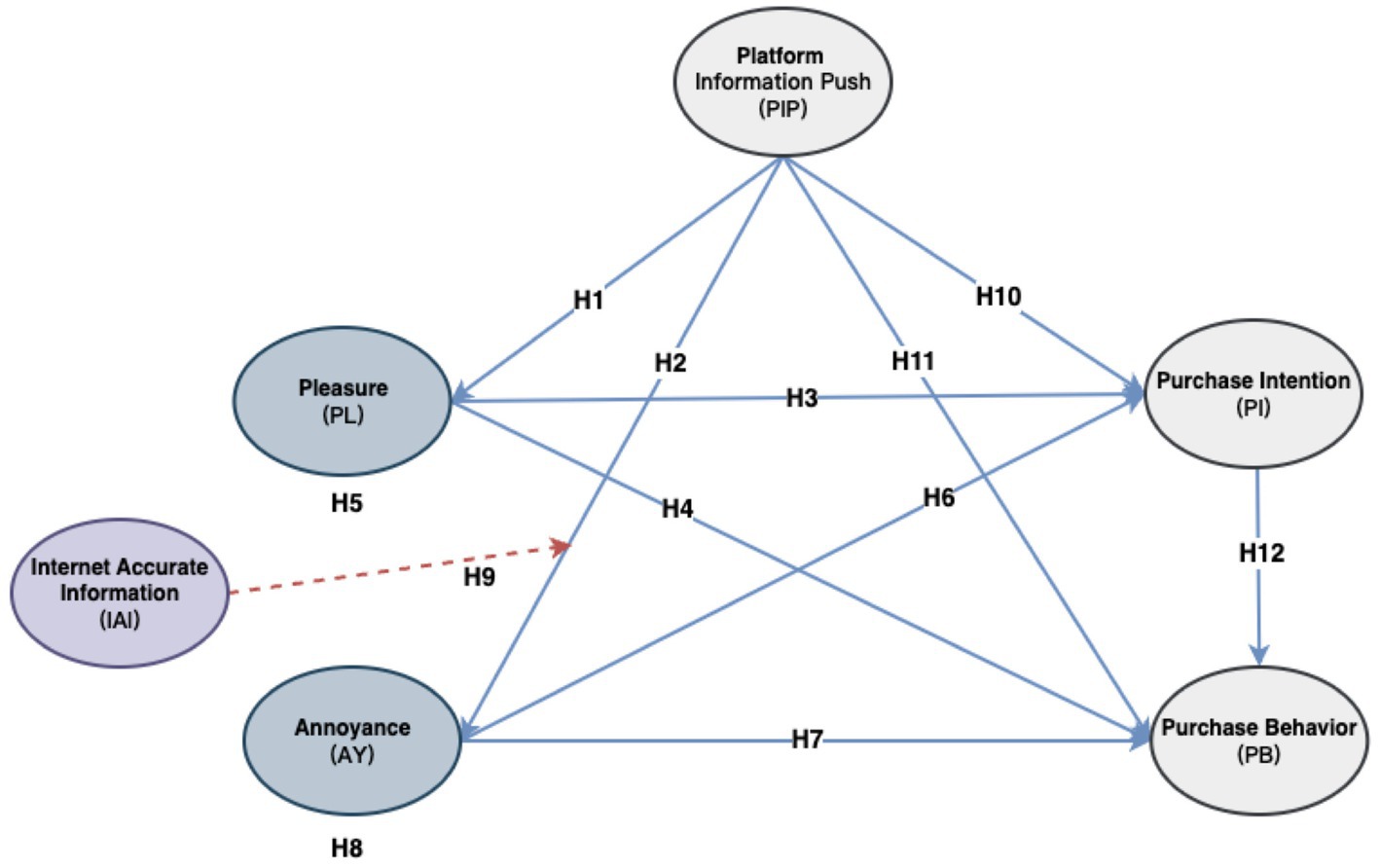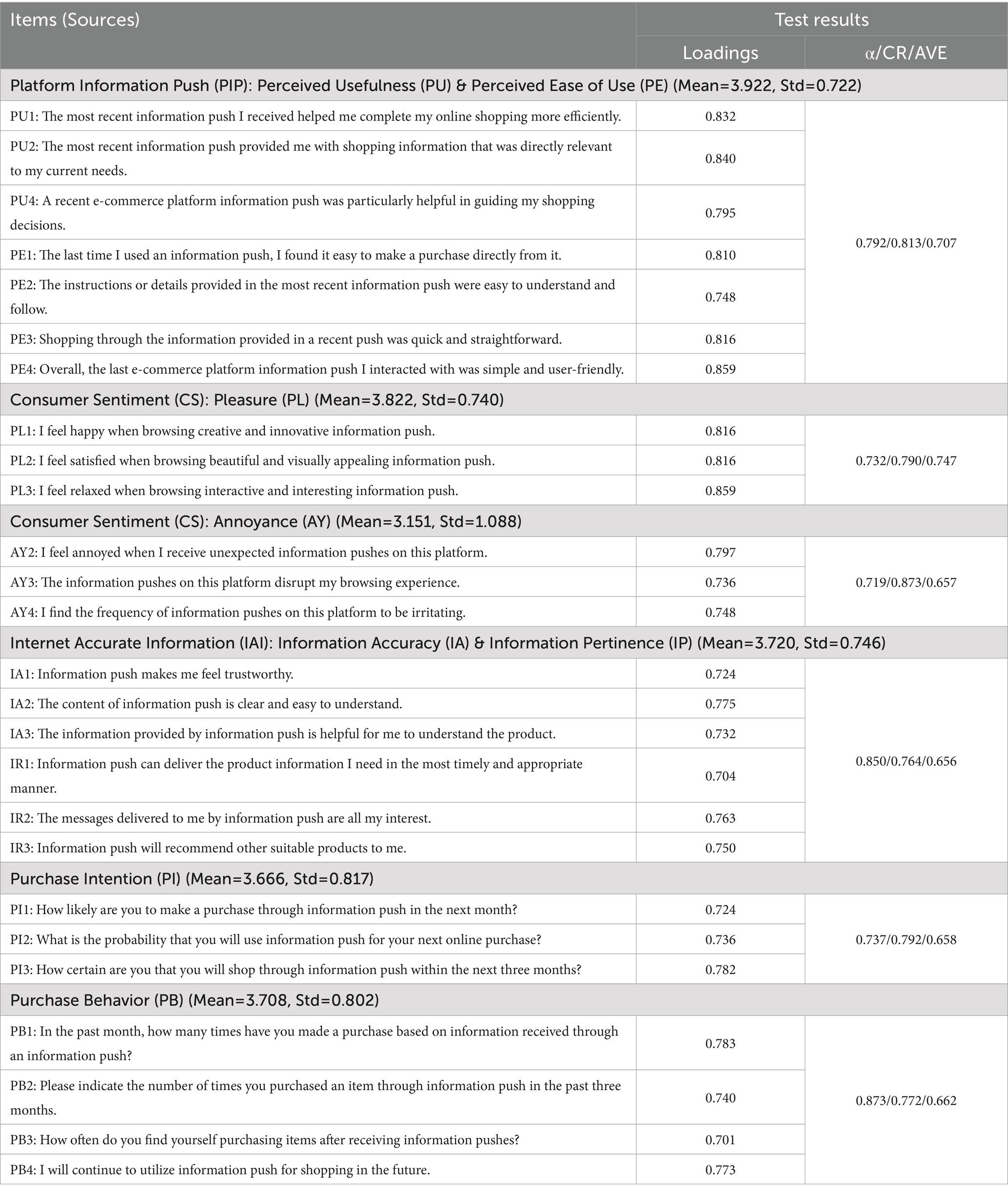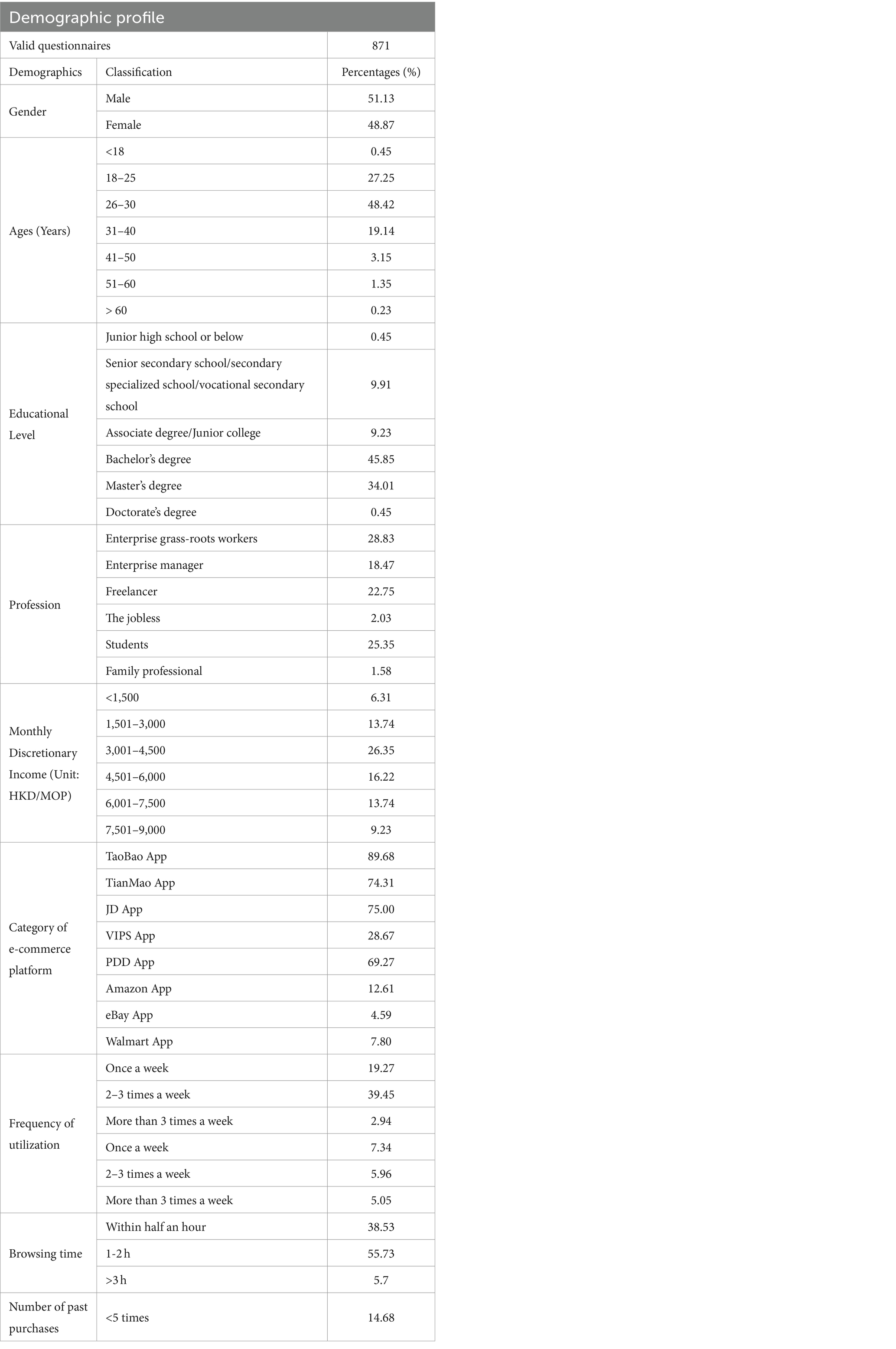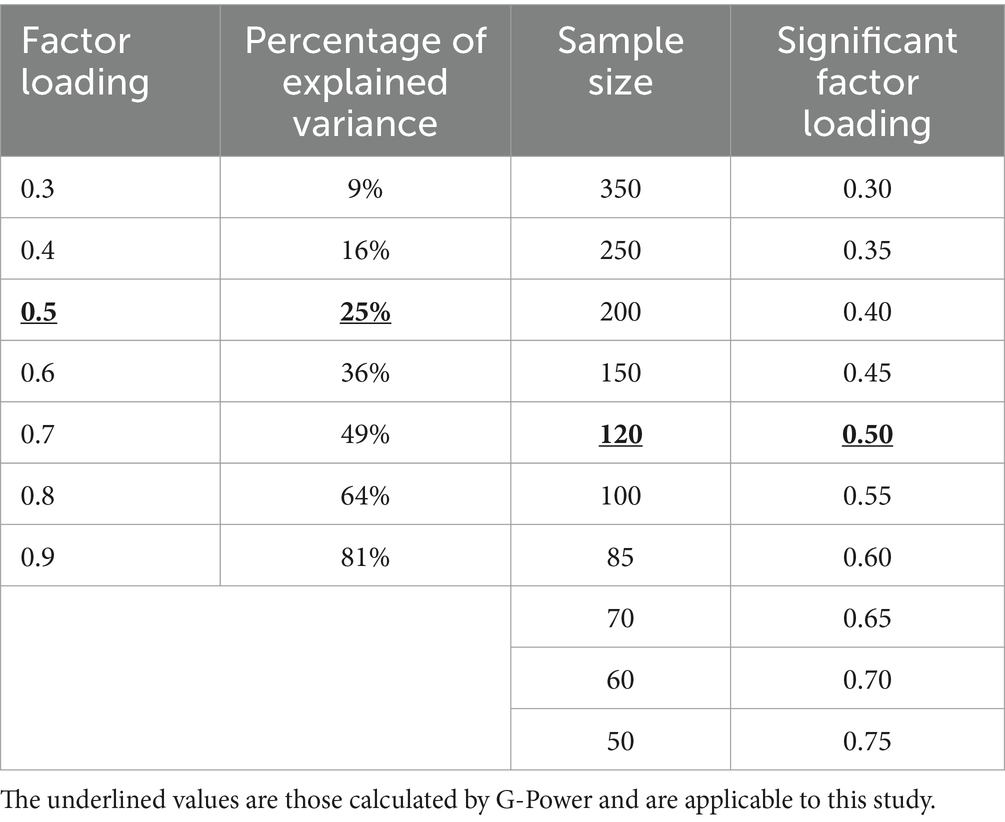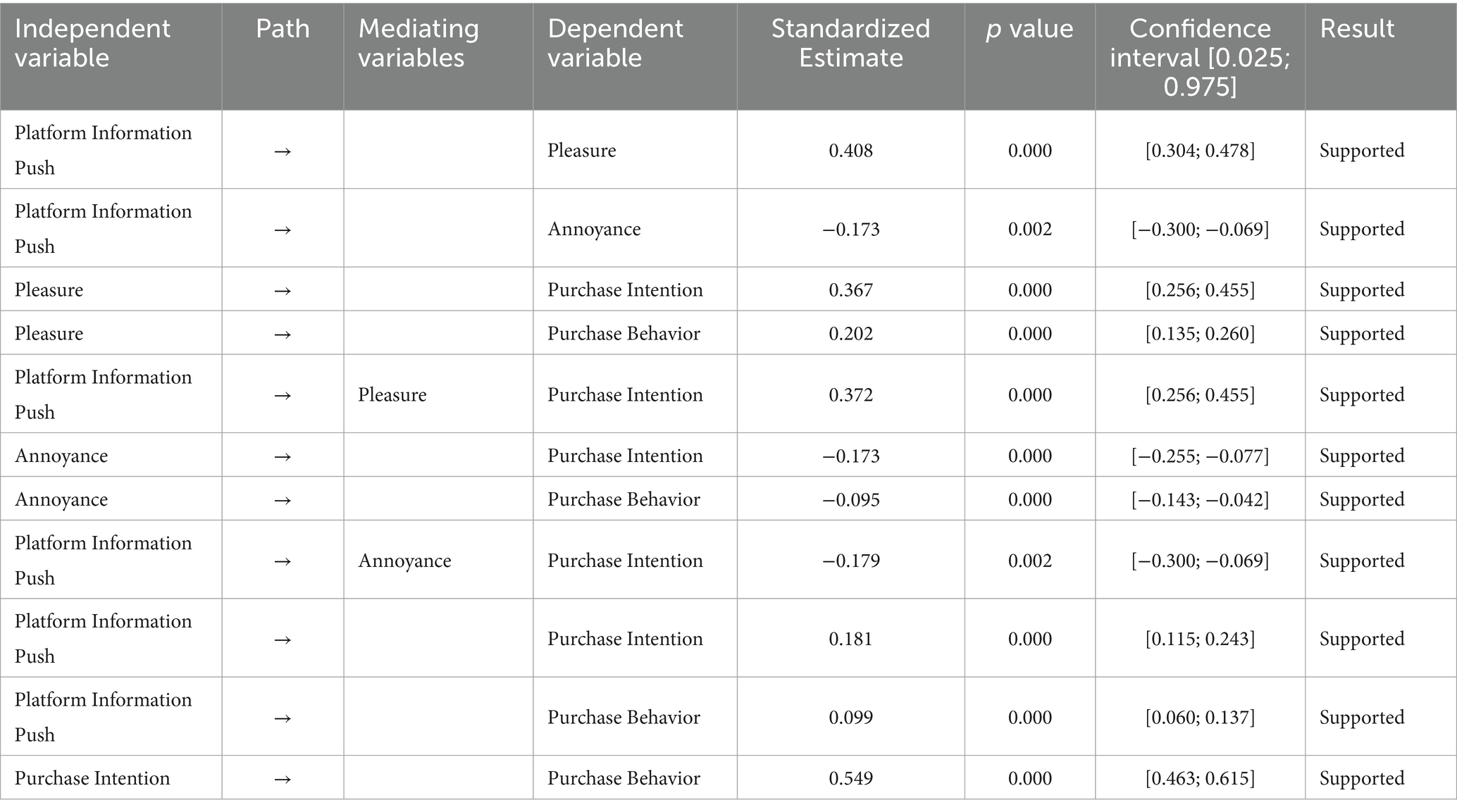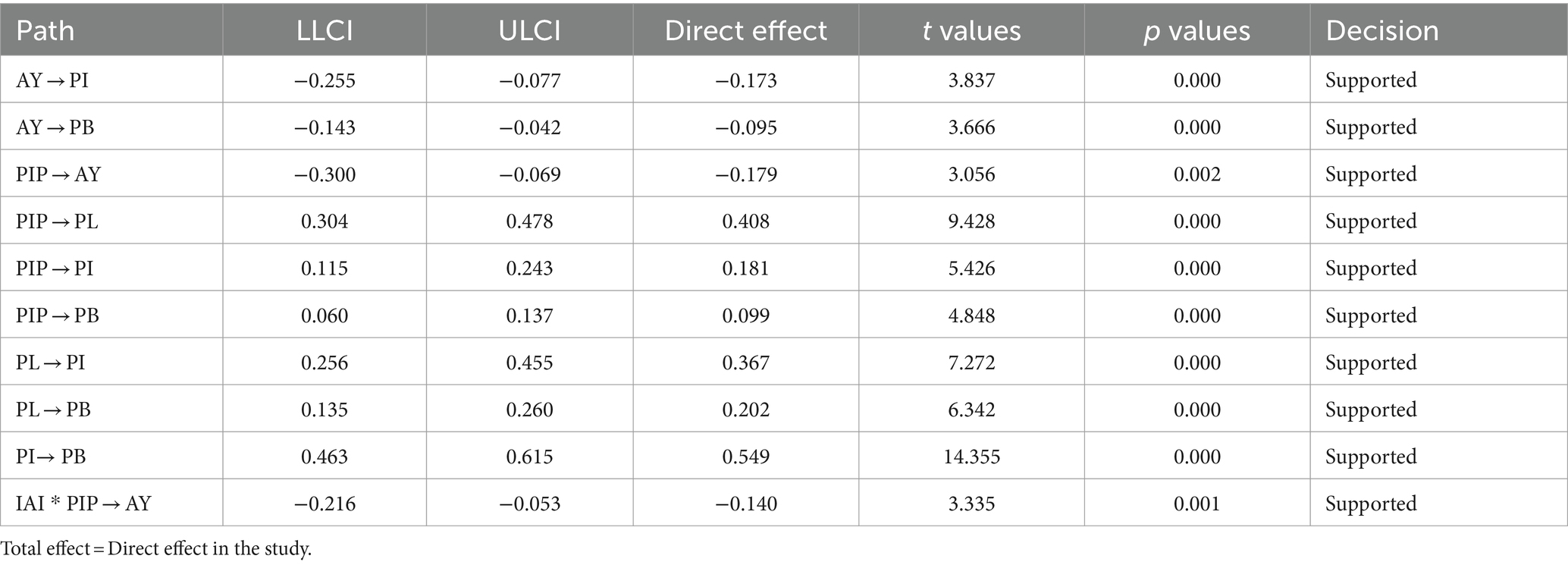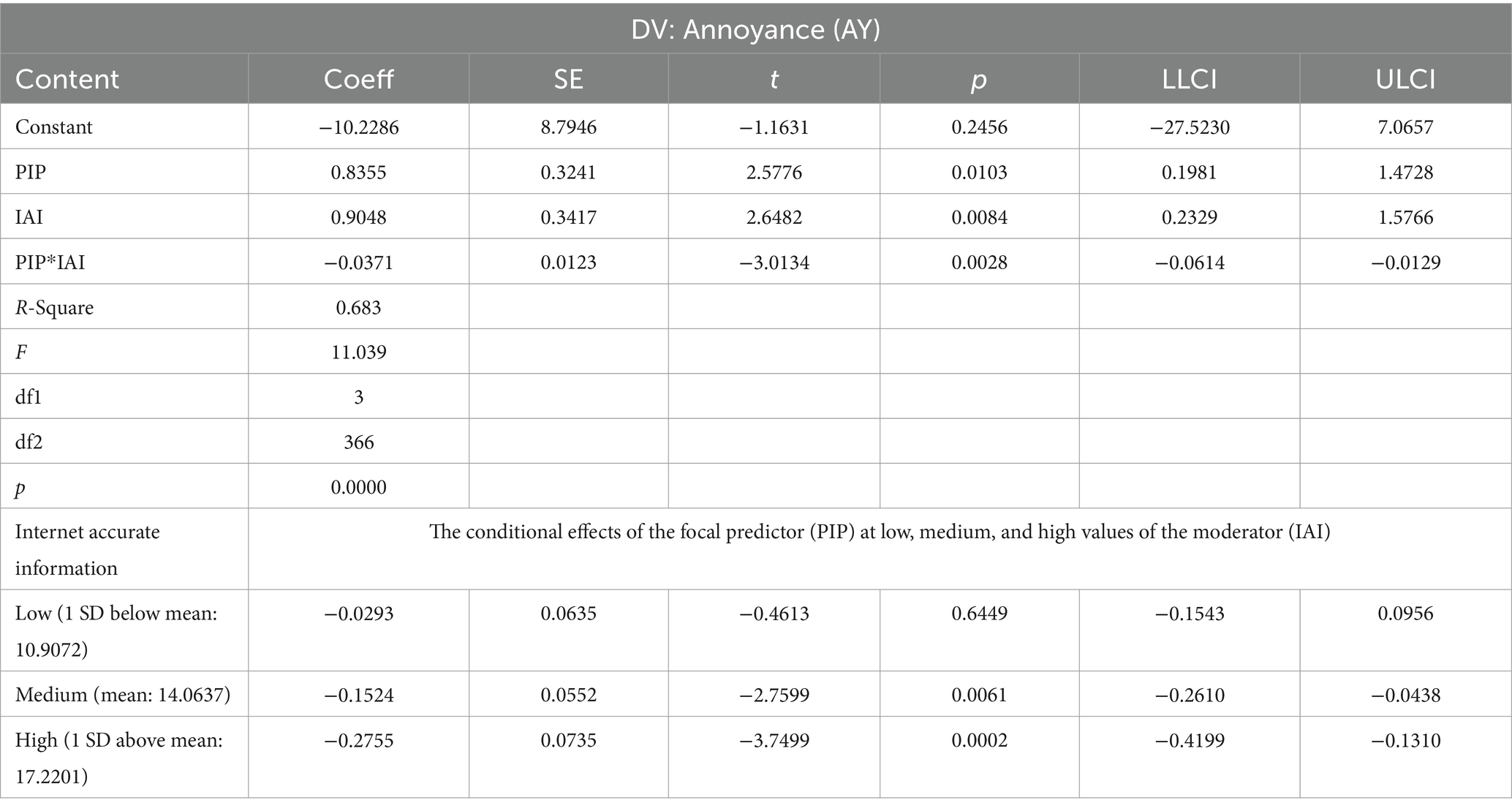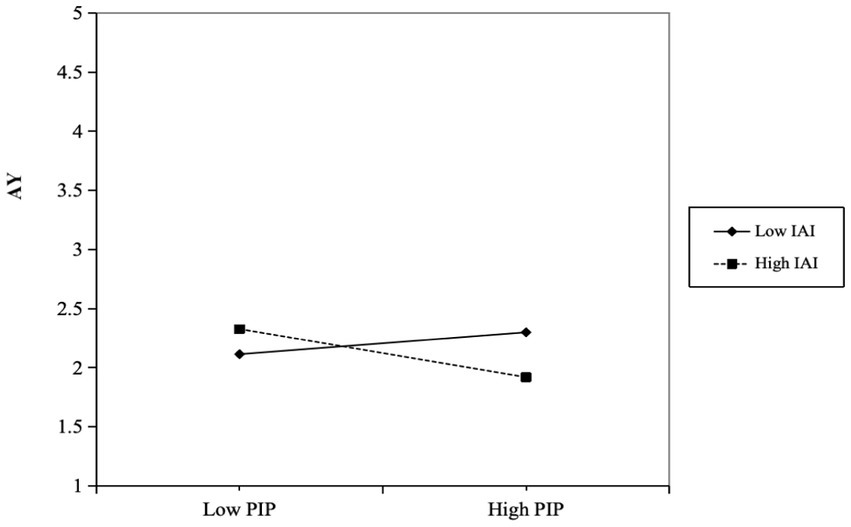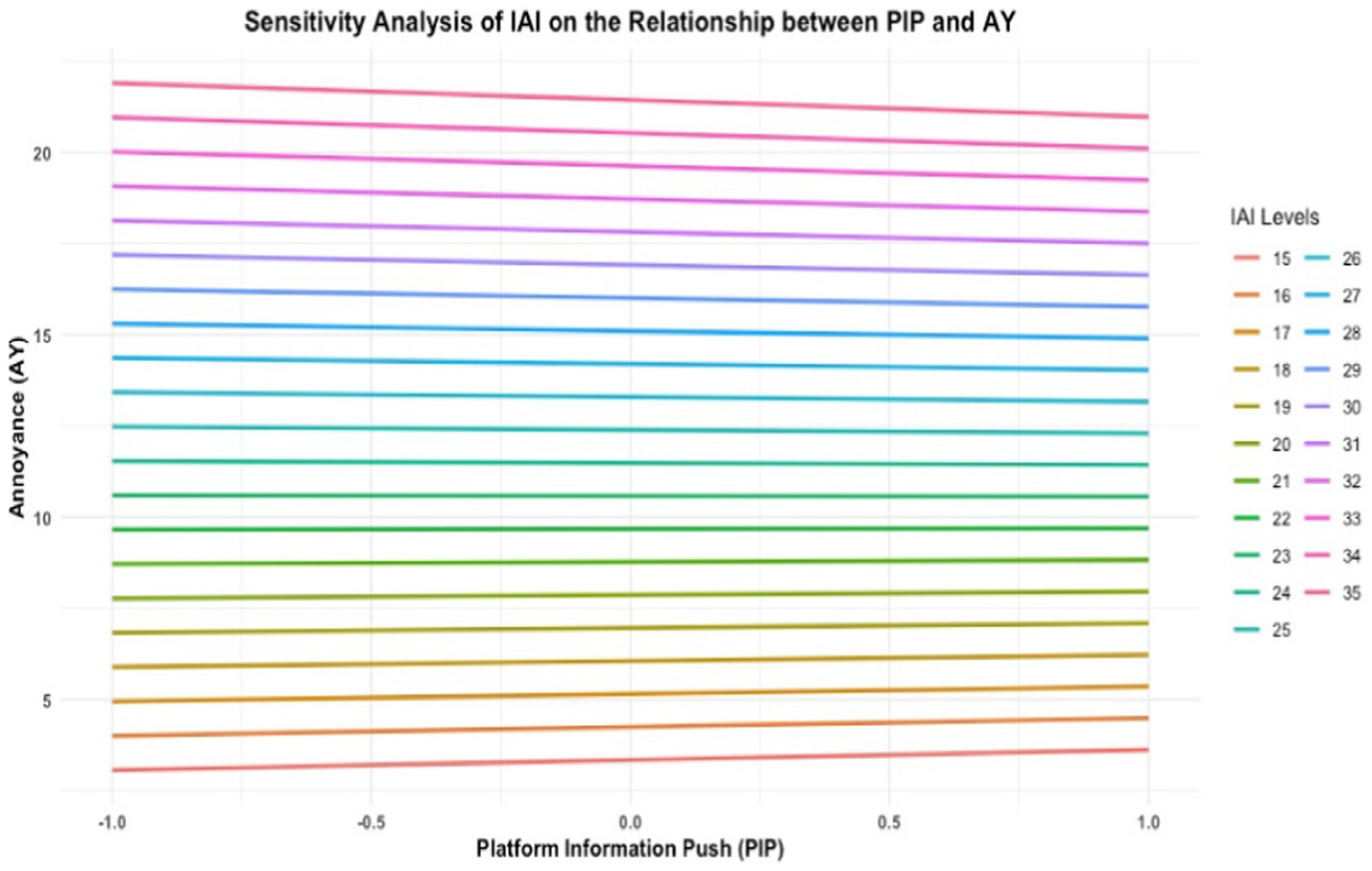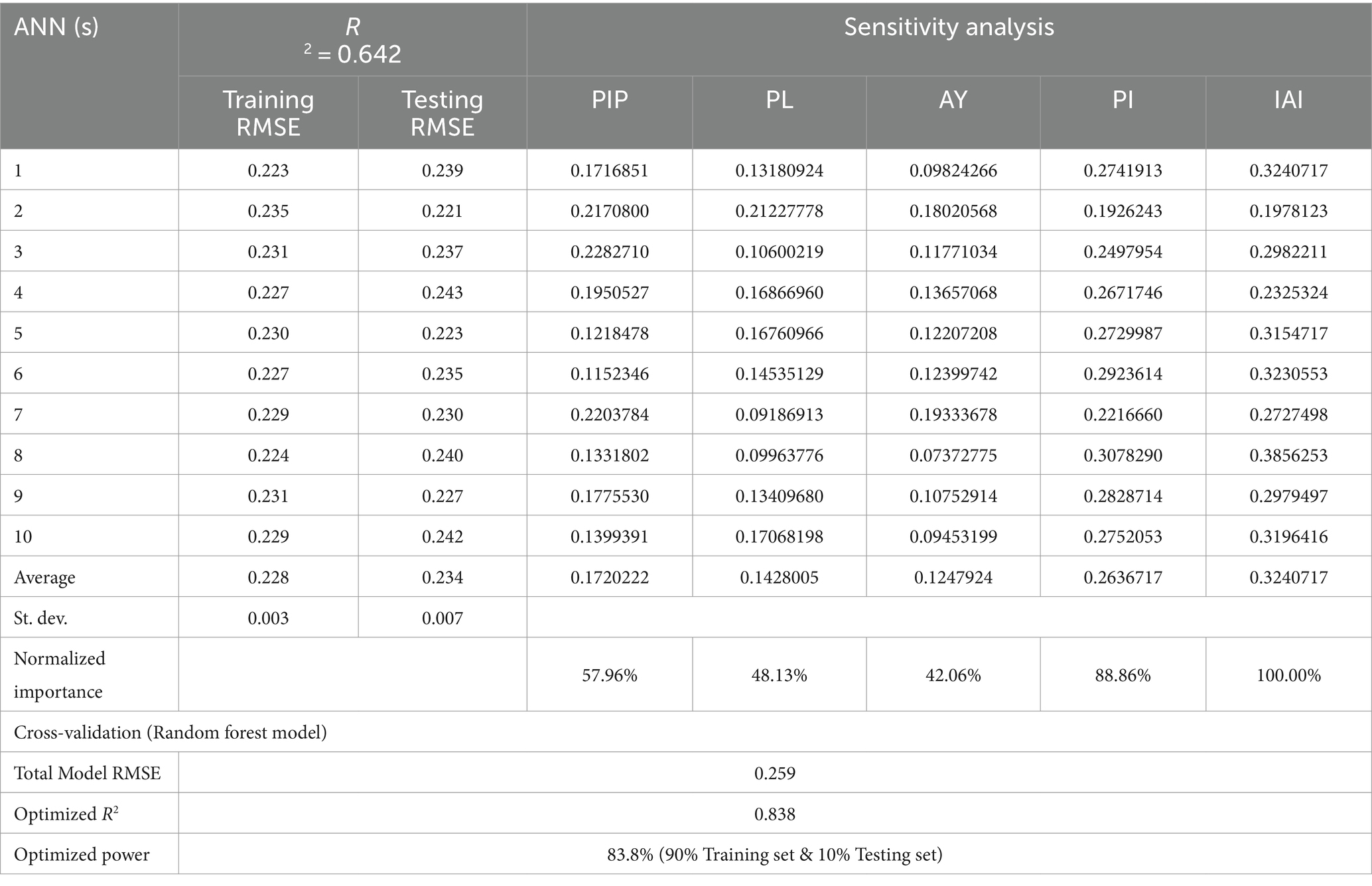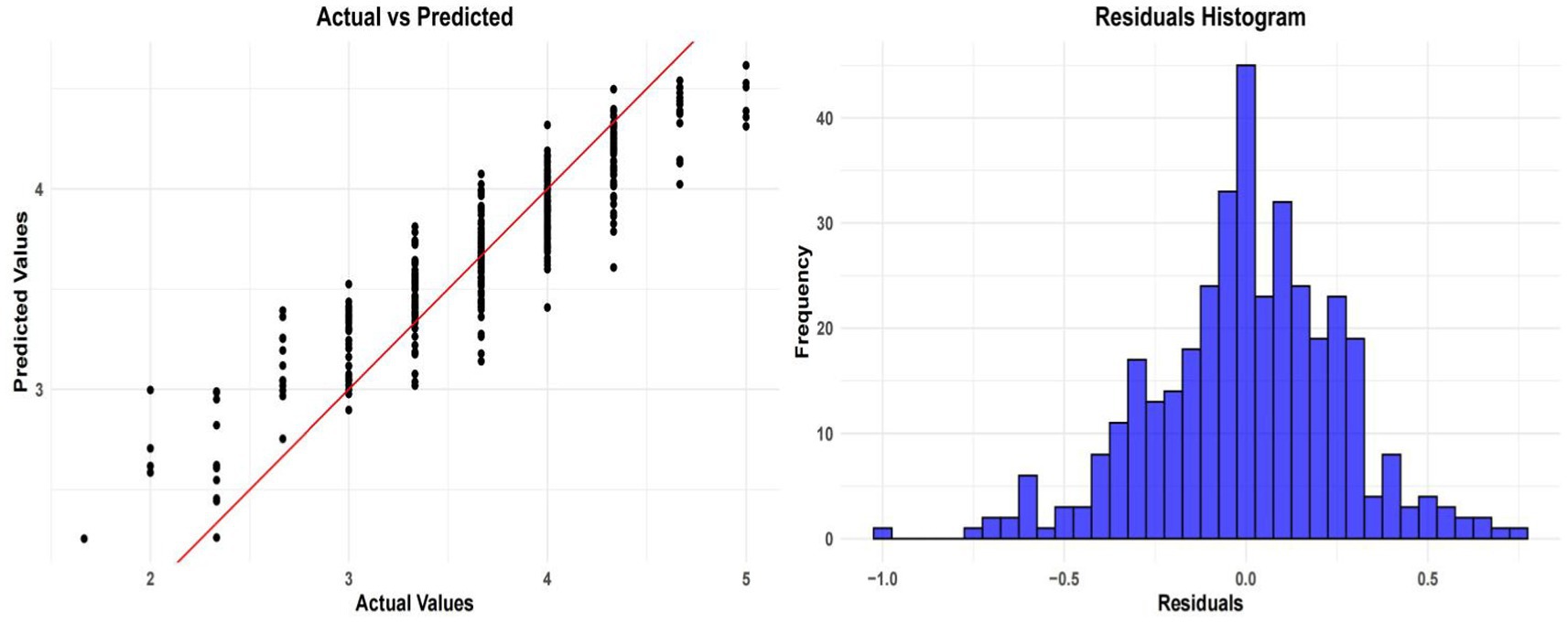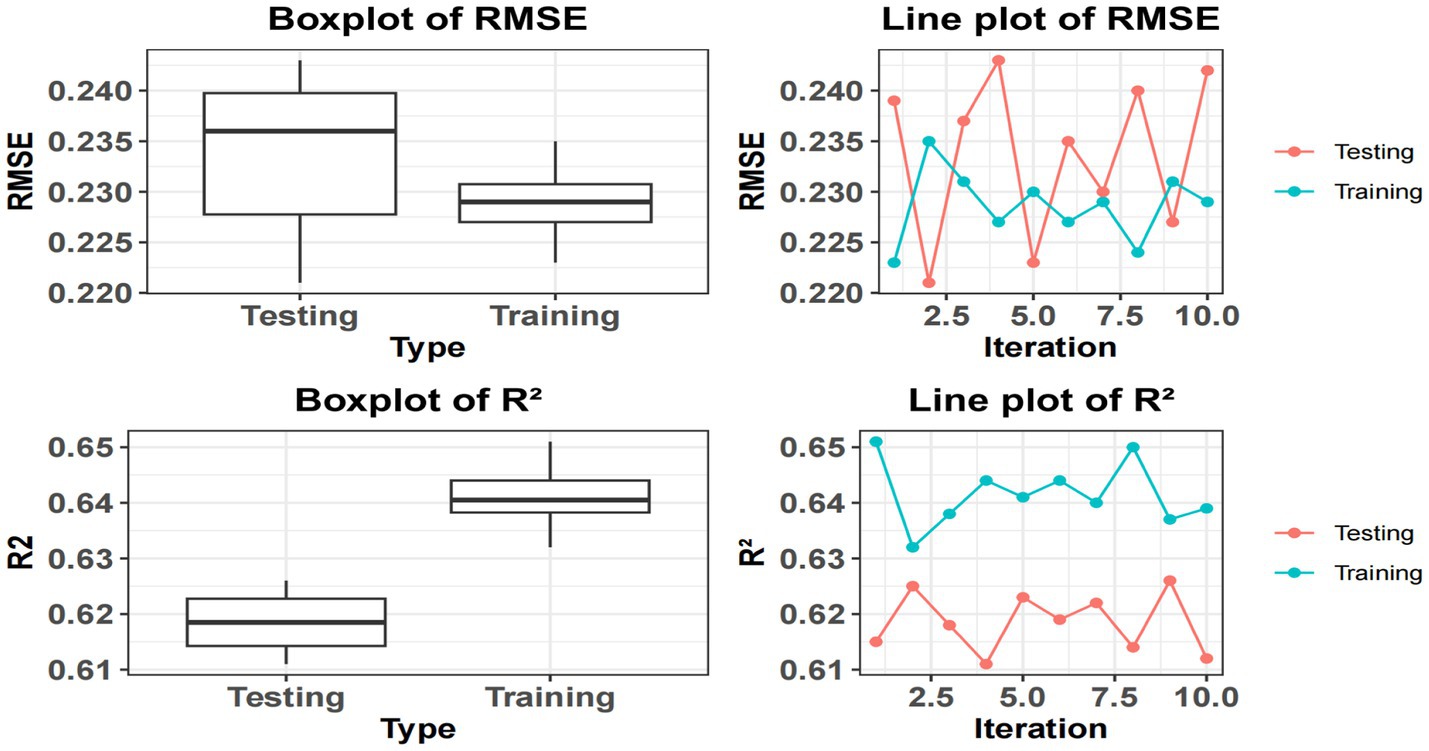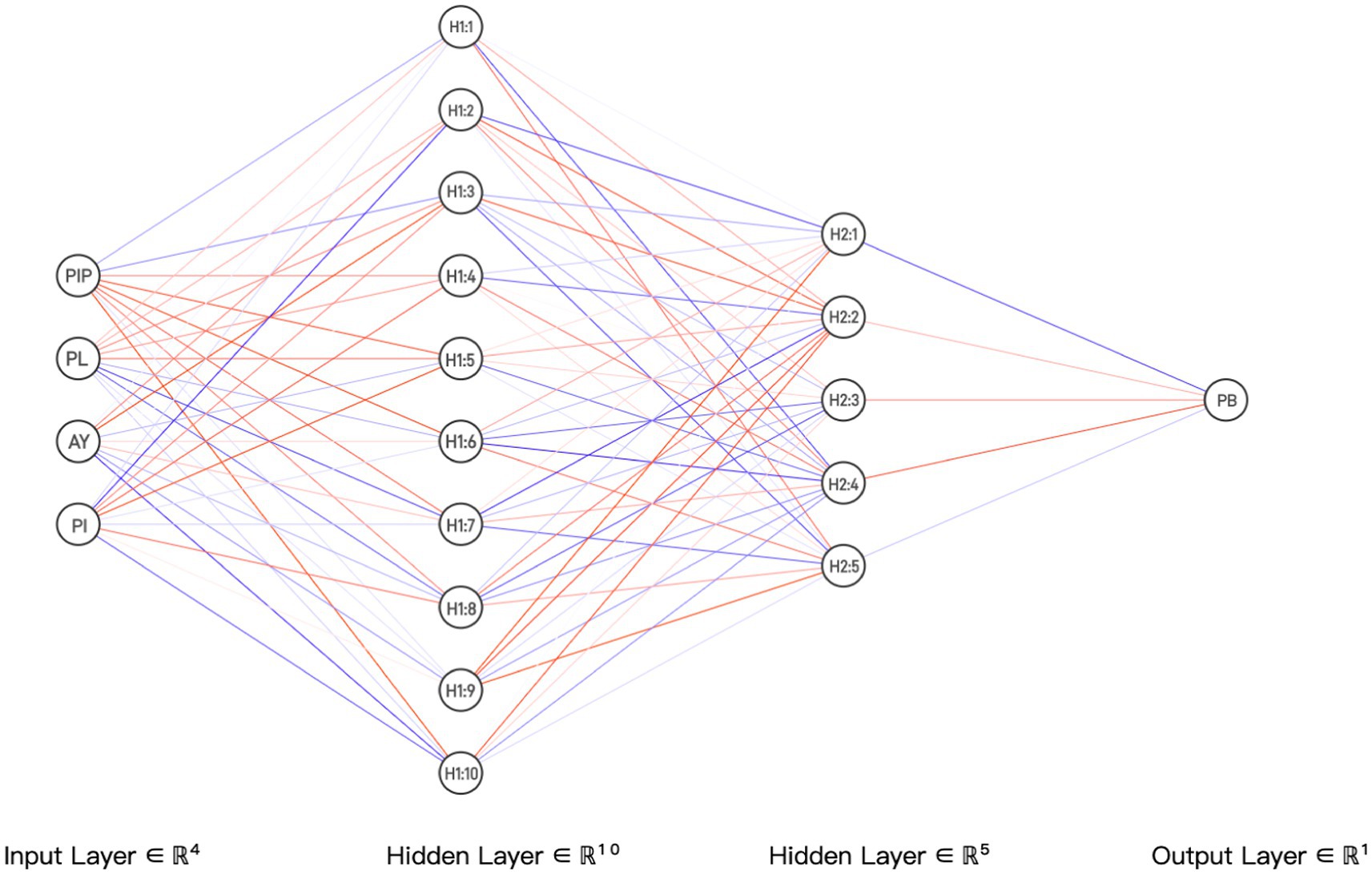- DEGEIT—Department of Economics, Management, Industrial Engineering and Tourism, University of Aveiro, Aveiro, Portugal
This study investigates the interplay between platform information push, consumer emotions, and purchase behavior in Macau’s cross-border e-commerce context using PLS-ANN analysis and piecewise linear regression. The findings reveal nuanced effects of information push on pleasure and annoyance, with distinct patterns emerging at different levels. These emotional responses significantly influence purchase intentions and actual behavior. Pleasure has a positive impact, while annoyance negatively affects outcomes. To optimize consumer sentiment and drive sales, e-commerce platforms should strategically manage information content, presentation, and timing. Harnessing positive emotions, balancing information sufficiency and overload prevention, and fostering long-term emotional connections are crucial. Adapting push strategies to diverse market preferences is vital for cross-border success. The study expands affect-as-information and emotional contagion theories, offering actionable suggestions for precision marketing. Future research should explore additional emotive dimensions, individual differences, and contextual moderators to enrich the model.
1 Introduction
In the era of information explosion, the exponential growth of data and the widespread use of the Internet have revolutionized traditional business marketing models, particularly in the e-commerce industry. The vast number of online consumers poses significant challenges for effectively executing marketing strategies that cater to their evolving psychologies and behaviors. Precision marketing, driven by big data, has emerged as a primary trend in digital marketing to address these challenges (Zou and Li, 2022). Extant literature has explored various aspects of precision marketing, such as constructing network click intention models (Yu et al., 2020), measuring advertisement effectiveness through emotion tracking (Otamendi and Sutil Martín, 2020), and examining the success factors of e-commerce platforms in attracting customer attention (Jun et al., 2021). However, there remains a paucity of research on the fluctuations of consumers’ emotions, both positive and negative, during the purchasing process, especially in the context of precision targeting. While studies have investigated the role of purchase intentions and the impact of online reviews on consumer emotions (Bigné et al., 2023; Guo et al., 2020; Miremadi et al., 2021), there is a need to bridge the gap between emotional responses and actual purchase behavior in precision marketing models.
To address the gap, the current study aims to investigate how platform information push influences consumer emotions, specifically pleasure and annoyance, and subsequently impacts online purchase intention and behavior in the context of Macau’s e-commerce market. Macau presents a unique research setting due to its special geographical location and economic characteristics. Like Hong Kong, Macau’s e-commerce platforms are primarily from mainland China. However, differences in the business environment and other factors lead to variations in platform usage and consumption patterns (Gichunge, 2018). Notably, Macau residents’ relatively high consumption level and perception of mainland products as affordable result in distinct dynamics within the e-commerce ecosystem (Lai and Lai, 2013). This situation mirrors the cross-border e-commerce phenomena observed in other regions, such as between Canada and the United States (Gichunge, 2018), Germany and Switzerland (Roy, 2023), France and its neighbors (Armstrong and Overton, 1977), and Singapore and Malaysia (Huang and Chang, 2019).
Focusing on Macau, this study aims to uncover insights that can be applied to other cross-border e-commerce contexts, where differences in economic development, consumer preferences, and platform offerings shape online purchase behavior. Understanding how precision marketing strategies can be tailored to these unique market conditions is crucial for e-commerce firms seeking to expand their reach and optimize their performance in diverse geographical settings.
Using affect-as-information theory (Schwarz, 2012) and emotional contagion theory (Hatfield et al., 1993), we propose a conceptual model that captures the mediating role of emotions in the relationship between information push and purchase outcomes. We empirically test our hypotheses using survey data collected from 871 users of e-commerce platforms in Macau, which provides a representative sample of cross-border online consumers.
The key contributions of this research are 3-fold. First, we elucidate the mediating role of emotions in the relationship between information push and purchase behavior, expanding the affect-as-information theory and emotional contagion theory. Second, we offer statistically significant recommendations for e-commerce platforms to maximize online sales by leveraging emotive motivators through impactful, irritation-reducing information pushes. Third, we contribute to the nascent literature on precision marketing by highlighting the importance of emotional resonance in driving consumer behavior.
2 Literature review
2.1 Affect-as-information theory
Affect-as-Information Theory, which posits that emotions and moods serve as crucial heuristic cues in consumer judgment and decision-making processes (Schwarz, 2012; Schwarz and Clore, 1983, 2003), has undergone significant theoretical advancements in recent years. The theory emphasizes the role of affect in guiding consumer evaluations and decisions, particularly when cognitive resources are limited, or affective information is highly relevant (Schwarz and Clore, 2003). Consumers frequently introspect on their emotional responses toward products, brands, or advertisements, which subsequently influence their purchasing intentions and behaviors (Peng et al., 2018; Zeithaml et al., 1996; Zanger D. et al., 2022; Zanger V. et al., 2022).
The stimulus-organism-response (SOR) framework provides a theoretical lens to understand how platform push information triggers emotional responses and shapes consumer behavior (Lerner et al., 2015; Hoffmann and Mai, 2022). Empirical studies consistently demonstrate the valence-congruent impact of emotions on purchase intentions, with positive emotions enhancing and negative emotions decreasing the likelihood of purchase (Kim and Lennon, 2013; Chien-Li and Mei-Jen, 2007; Li et al., 2024). These findings align with the core tenets of Affect-as-Information Theory, which asserts that consumers automatically integrate their emotional states into their decision-making processes, often without conscious awareness (Winkielman et al., 2003; Schwarz, 2012; Schwarz and Clore, 1983, 2003).
Recent research has expanded the boundary conditions and applications of Affect-as-Information Theory, further validating its relevance in understanding consumer behavior. For instance, Su et al. demonstrated how service quality in crisis situations, such as the COVID-19 pandemic, can evoke strong emotional responses that shape consumer loyalty through psychological distress and emotional states. This study highlights the theory’s explanatory power beyond traditional marketing contexts. Moreover, Affect-as-Information Theory has been instrumental in understanding consumer privacy concerns in digital marketing. Wang et al. (2023) employed the FCB grid model to reveal how privacy concerns evoke significant emotional responses, influencing consumer attitudes and behaviors toward advertisements. This research underscores the theory’s premise that emotions act as critical informational cues, especially when trust and privacy are paramount concerns.
The theory’s applicability also extends to service interactions, where emotional displays by employees significantly influence customer behavior. Chen et al. (2006) found that both customer and employee affective displays serve as potent informational cues, shaping customer satisfaction and loyalty. This finding highlights the theory’s versatility in explaining consumer behavior across various interactional contexts.
Ashtar et al. (2023) further extended the theoretical framework by exploring how affective displays not only serve as information but also trigger emotional contagion, thereby influencing group dynamics and collective consumer behavior. This research emphasizes the dual role of affect as both a personal heuristic and a social influencer. In the context of supply chain management, Zhao et al. revealed that the perceived quality of logistics services during the pandemic significantly impacted consumer emotions, which in turn influenced their purchasing decisions and loyalty. This insight underlines the importance of integrating affective responses in crisis situations where consumer trust is pivotal. Furthermore, Li et al. (2024) expanded the traditional understanding of Affect-as-Information Theory by incorporating logistical factors that impact consumer emotions and behaviors in the evolving landscape of online retail and physical distribution services during the COVID-19 pandemic. Lastly, Darragi et al. (2024) demonstrated the theory’s applicability in the context of augmented reality (AR) applications in luxury retail, showing how AR-driven experiences enhance consumer engagement through the immersive and emotionally resonant nature of the technology.
The extent to which consumers rely on their emotions as information depends on several moderating factors, such as the perceived informational value of the affective state, the availability of alternative information, and the attribution of affect to the target object (Schwarz and Clore, 2003; Al-Refaie, 2015; Pham et al., 2013). Moreover, reliance on affect is particularly useful in situations where quick decisions are necessary, as it does not require extensive cognitive processing (Peng et al., 2018; Schwarz and Clore, 2003; Siemer and Reisenzein, 1998; Chan et al., 2023).
2.2 Emotional contagion theory
Emotional Contagion Theory, which refers to the process by which an individual or group influences the emotional states or behaviors of another person or group through both intentional and unintentional induction of emotional experiences (Balconi et al., 2022; Hatfield et al., 1993), has undergone significant theoretical advancements in recent years. The theory posits that emotional contagion originates from an “association-learning” mechanism, where individuals develop congruent emotions by associating observed affective cues with their own emotional experiences (Hoffman, 1984). Through repeated exposure and mimicry, individuals deepen their emotional alignment with others, ultimately shaping their behaviors.
The theory distinguishes between two primary forms of emotional contagion: transient psychological responses during interpersonal interactions and enduring psychological states cultivated under the persistent influence of short-term emotional cues (Balconi et al., 2022; Heesup and Ki-Joon, 2007). In the context of e-commerce, platform information dissemination acts as a stimulus that can trigger both immediate and lasting emotional responses in consumers. The content, presentation, and timing of the information pushed by platforms play a crucial role in inducing these emotional experiences.
Consumers typically undergo two levels of psychological changes in response to platform information. Initially, they may experience emotions such as pleasure or annoyance when their personal needs are either fulfilled or frustrated by the platform’s information. Research by Cheshina et al. (2018) demonstrated that individuals are more likely to trust those who provide positive experiences, highlighting the link between positive emotions and trust in the platform. Conversely, negative experiences, such as receiving irrelevant or intrusive information, can lead to distrust and negative emotional evaluations (Zhou and Tong, 2022; Chen et al., 2021).
The impact of platform information on consumer psychology and behavior largely depends on the interaction between the platform and the consumer. The frequency, relevance, and quality of information pushed by the platform influence the level of consumer engagement and subsequent emotional responses. Gao et al. (2021) found that higher consumer engagement, driven by active participation and a sense of belonging, enhances positive emotional experiences. Emotional contagion can also occur between consumers, particularly when they share their experiences and opinions related to the platform’s information (Chien-Li and Mei-Jen, 2007). These consumer-to-consumer interactions not only provide valuable product information but also influence consumers’ perceptions of the platform’s trustworthiness and reliability.
Previous and recent studies have expanded the understanding of emotional contagion in various contexts, providing empirical evidence and theoretical insights. Kramer et al. (2014) demonstrated the occurrence of emotional contagion on a large scale through social networks, highlighting the spread of emotions without direct interaction or nonverbal cues. Wu and Wen (2019) explored the impact of emotional contagion in advertising, showing that emotional states significantly affect the effectiveness of comparative vs. non-comparative advertisements. Bakri et al. (2024) linked emotional contagion through imagery to behavioral intentions in the context of tourism-related decisions, while Li et al. (2024) revealed how emotionally charged online customer reviews can influence other readers’ emotions and purchasing decisions. Researchers have investigated the role of emotional contagion in virtual workspaces, brand loyalty in retail, crisis communication, and online communities. These studies have identified key factors influencing the spread of emotions, such as communication style, frequency, and the control of emotional narratives, while also highlighting the potential negative consequences of emotional contagion, such as panic, misinformation, and exacerbated mental health issues (Figure 1).
3 Research hypothesis development
3.1 Platform information push and consumer sentiment
According to the Affect-as-Information Theory, emotions serve as a vital source of information in consumers’ judgment and decision-making processes (Schwarz, 2012; Schwarz and Clore, 1983). When consumers receive information pushed by an e-commerce platform, they often evaluate the usefulness and ease of use of this information in their shopping decisions (Peng et al., 2018; Zanger D. et al., 2022; Zanger V. et al., 2022). If consumers perceive the pushed information as useful and easy to use, they are more likely to experience pleasure while browsing. This pleasure may arise from the information helping them complete their shopping more efficiently, providing shopping information that is directly relevant to their current needs, and making the shopping process simple and straightforward. Therefore, pleasure (PL) reflects the positive emotional responses consumers experience when interacting with creative, visually appealing, and interactive information pushes.
On the other hand, according to the Emotional Contagion Theory, the content, presentation, and timing of the pushed information can evoke emotional responses in consumers (Balconi et al., 2022; Hatfield et al., 1993). When the pushed information is irrelevant to the consumers’ needs or is frequent and intrusive, it may trigger feelings of annoyance (AY). This annoyance is typically expressed as frustration with unexpected information pushes, the disruption of their browsing experience, and irritation with the frequency of these pushes. Therefore, annoyance reflects the negative emotional responses consumers experience when receiving irrelevant or excessive information pushes (Cheshina et al., 2018; Heesup and Ki-Joon, 2007).
We argue that when the platform pushes relevant, timely, and high-quality information, it can evoke positive emotions (pleasure) in consumers, leading to favorable evaluations and increased purchase intention. In contrast, poorly designed or intrusive information push may cause negative emotions (annoyance), resulting in unfavorable attitudes and decreased purchase likelihood. The emotional responses elicited by the platform’s information push serve as important informational cues that shape consumers’ judgments and decisions, as posited by the Affect-as-Information Theory. Moreover, the Emotional Contagion Theory suggests that these emotional experiences can be further reinforced through consumer-to-consumer interactions, influencing the overall perception of the platform’s trustworthiness and reliability. We propose the following hypotheses:
H1. “Platform Information Push” has a positive impact on “Pleasure.”
H2. “Platform Information Push” has a negative impact on “Annoyance.”
3.2 Consumer sentiment, purchase intention, and purchase behavior
Recent research has made significant progress in understanding the relationship between consumer sentiments and behaviors. Sentiments are defined as intense fluctuations related to environmental stimuli that influence decision-making (Doran et al., 2022; Ning and Hu, 2022). The Affect-as-Information Theory provides a theoretical foundation for understanding the role of sentiments in consumer decision-making. According to this theory, consumers rely on their affective states as informational cues when making judgments and decisions (Schwarz, 2012; Schwarz and Clore, 1983). Positive sentiments, such as pleasure, can enhance purchase intention and behavior, while negative sentiments, like annoyance, may reduce them (Peng et al., 2018; Zanger D. et al., 2022; Zanger V. et al., 2022). Moreover, the extent to which consumers rely on their sentiments depends on factors such as the informational value, relevance to the specific judgment, and accessibility of alternative information (Schwarz and Clore, 2003).
In the context of e-commerce platform information push, aligning the pushed information with consumers’ needs can create a sense of “pleasure,” which in turn increases purchase intention. Visually appealing information that meets consumers’ goals captures their attention and satisfaction, thereby stimulating “purchase behavior” (Liu et al., 2013; Brüns and Meißner, 2023). For example, when a consumer feels pleasure from a platform’s information push, they are more likely to consider making a purchase in the future, have a high probability of using the information push for their next online purchase, and feel confident about shopping. Designing information that triggers motivation and positive emotions creates a “pleasure” mindset, which not only raises purchase intention but also can lead to increased repurchasing and positive word-of-mouth (Palmatier et al., 2009).
On the other hand, continuously pushing irrelevant information can lead to “annoyance,” decreasing trust and purchase intention (Wei et al., 2023). For instance, if the information push lacks usefulness or is difficult to navigate, this can cause annoyance, leading consumers to reduce their likelihood of making a purchase based on the pushed information. This is reflected in how often they purchase items after receiving an information push and whether they continue to utilize information pushes for shopping in the future. Thus, we suggest that “annoyance” partially mediates the relationship between information push and purchase intention, as it can undermine consumers’ willingness to engage with the platform’s offerings. We propose the following hypotheses:
H3. “Pleasure” has a positive impact on “Purchase Intention.”
H4. “Pleasure” has a direct and positive impact on “Purchase Behavior.”
H5. “Pleasure” plays a positive mediating role between “Platform Information Push” and “Purchase Intention.”
H6. “Annoyance” has a negative impact on “Purchase Intention.”
H7. “Annoyance” has a direct and negative impact on “Purchase Behavior.”
H8. “Annoyance” plays a negative mediating role between “Platform Information Push” and “Purchase Intention.”
3.3 Internet accurate information, platform information push, and annoyance
The Affect-as-Information Theory posits that emotions serve as informational cues that influence consumers’ judgments and decision-making (Schwarz, 2012; Schwarz and Clore, 1983). In the context of e-commerce, delivering aligned marketing information to consumers’ devices enables more precise strategies and higher sales effectiveness (Zhou and Tong, 2022; Zou and Li, 2022). By leveraging robust databases and technologies, businesses can measure consumer behavior and provide customized, relevant information. However, challenges exist in practice. Lower precision in demand identification can lead to the delivery of irrelevant information, while overly simplistic delivery methods may reduce consumer acceptance (Grigorios et al., 2022). Moreover, frequent advertising information delivery can trigger feelings of “annoyance,” negatively impacting the effectiveness of the marketing efforts.
To address these issues, various solutions have been proposed (Tabuena et al., 2022). For example, adjusting strategies to increase effectiveness and conversion rates can help alleviate consumer annoyance. Given the current state of e-commerce information delivery, it is important to examine the moderating effect of online precision information on the relationship between information push and “annoyance” (Koo and Ju, 2010; Tabuena et al., 2022). This approach aims to establish a remedial mechanism when negative emotions arise due to suboptimal information delivery. We propose the following hypothesis:
H9. “Internet Accurate Information” positively moderates the relationship between “Platform Information Push” and “Annoyance.”
3.4 Platform information push, purchase intention and behavior
Previous research has established the positive impact of information source on purchase intentions and behavior (Ning and Hu, 2022). In the context of this study, purchase intention is defined as consumers’ willingness and intention to transact online (Zhou and Tong, 2022), which involves searching, selecting, and purchasing products through the internet.
Attitude and sentiment significantly influence purchase intention (Kartika, 2019). E-commerce platforms leverage big data to deliver relevant messages, aiming not only to inform consumers but also to influence their sentiments and establish trust for continuous feedback. The design and models of information push impact sentiment perception, and effectively established trust ultimately influences purchase intention (Gichunge, 2018). The strength of users’ purchase intention, in turn, determines their actual purchase behavior (Bulsara and Vaghela, 2023).
The Affect-as-Information Theory supports the role of emotions in shaping consumer judgments and decisions (Schwarz, 2012; Schwarz and Clore, 1983). In the context of e-commerce, platform information push can evoke positive or negative emotions, such as pleasure or annoyance, which serve as informational cues influencing purchase intention and behavior. The extent to which consumers rely on their emotions depends on factors such as the informational value, relevance to the specific judgment, and accessibility of alternative information (Schwarz and Clore, 2003). We propose the following hypotheses:
H10. “Platform Information Push” has a direct positive impact on “Purchase Intention.”
H11. “Platform Information Push” has a direct positive impact on “Purchase Behavior.”
H12. “Purchase Intention” has a positive impact on their “Purchase Behavior.”
4 Research methodology
4.1 Measures, sample, and data collection
We conducted a quantitative survey to investigate the impact of platform information push on consumers’ emotions and purchase behavior in Macau’s e-commerce market. The target population consisted of Macau consumers who use major e-commerce platforms (Taobao, Pinduoduo, JD.com) and social tools (WeChat, Xiaohongshu, Facebook). Convenience sampling was employed to obtain a diverse and representative sample from the Macau Peninsula, Taipa, and Coloane. The survey was distributed online through social media platforms (Facebook, Instagram, and WeChat) and e-commerce communities, as well as in paper form at shopping malls, universities, and offices across Macau.
Data collection was carried out in three rounds over a period of 9 months due to the difficulties in data acquisition in Macau. A total of 1,000 responses were collected, with 871 valid responses remaining after data cleaning, exceeding the minimum requirement for structural equation modeling (SEM) (Wei et al., 2023). The survey consisted of four sections: (1) Demographics; (2) Sentiment on platform information (five-point Likert scale); (3) Purchase intention based on information; (4) Actual purchases (frequency, platforms, and products).
A pilot study with 50 participants resembling the target group was conducted to test the survey’s validity, reliability, and clarity, resulting in minor adjustments. The Macau Peninsula sample was deemed representative based on its high population density, convenient transportation, diverse socioeconomic residents, educational institutions, and screening for significantly influenced platform users. The sample size met the acceptable range with strong representation per statistical testing and background distributions validating local resident representation (Consumer Council of Macau, 2023).
SPSS 26.0 was used for demographic data analysis and descriptive statistics. Collinearity issues were assessed using the coefficient of variation (VIF value). Reliability and validity tests were conducted, with items having factor loadings below 0.5 removed. Exploratory Factor Analysis (EFA) was employed to redefine dimensions, and average variance extraction (AVE) was computed. Descriptive statistics demonstrated significant explanatory power (p < 0.05) in real-world contexts.
Because the data were not normally distributed, partial least squares structural equation modeling (PLS-SEM) was selected for predictive analysis using Python 3.11.4, which facilitates modeling complex relationships and is well-suited for non-normal data. The conceptual framework’s pathways, including direct effects, mediations, and moderation, were examined. The significance of all effects was verified through bootstrapping. PLS-SEM was deemed more advantageous than CB-SEM for this study due to its relaxation of normal distributional assumptions, ability to estimate intricate models with reduced sample sizes, and suitability for exploratory research, theory development, and prediction (Hair, 1998; Setyani et al., 2019; Khan et al., 2019; Sharma et al., 2023; Hair et al., 2021).
4.2 Ethics statement
According to the regulations of the Macau SAR and local institutions, this study has been deemed exempt from ethics and licensing review. Prior to conducting the research, participants were provided with both oral and written information and their informed consent was obtained. This ensures compliance with local legal and ethical requirements.
4.3 Scale sources
During the survey, respondents were asked to rate their level of agreement with various statements using a five-point Likert scale. The scale ranged from “strongly disagree” (1) to “strongly agree” (5). Table 1 presents the measurements obtained from multiple studies. The construct of Platform Information Push (PIP) is adapted from Davis (1989), Vijayasarathy (2004), and Shin (2009), incorporating dimensions such as Perceived Usefulness (PU) and Perceived Ease of Use (PE). The measurement of Consumer Sentiment (CS) is derived from previous researchers, including pleasure measurement from Mehrabian and Russell (1974), Khan et al. (2019), and Wei et al. (2023), mainly utilizing a multidimensional emotions scale (AEQ). The measurement of annoyance is based on the annoyance scale developed by Kronrod and Huber (2019) and reconstructed items for this study. The construct of Internet Accurate Information (IAI) was developed for this research, to measure two hypothetically distinct dimensions, information accuracy (IA) and information pertinence (IP). The items measuring Purchase Intention (PI) and Purchase Behavior (PB) are taken from Dodds et al. (1991), Zeithaml et al. (1996), Henderson and Divett (2003), and Morwitz (2014), with adaptations made to align with the context of online purchases. See Table 1.
5 Data analysis and results
5.1 Descriptive statistics
Table 2 shows the study collected 871 valid questionnaires from participants representing a balanced gender distribution (396 males, 475 females). The majority of respondents were aged 26–30 (48.42%), followed by 18–25 (27.25%). Education-wise, most had a bachelor’s degree (45.85%), while master’s degree holders accounted for 34.01%. Occupation-wise, enterprise grassroots workers were the largest group (28.83%), followed by students (25.35%). Taobao was the dominant e-commerce platform (89.68%), with TianMao, JD, and Pinduoduo having significant market shares. The pandemic led to increased platform usage (2–3 times/week, 39.45%) and higher purchase frequency (≥15 times, 66.97%).
5.2 Nonresponse bias
Nonresponse bias arises when individuals who do not respond to a questionnaire potentially bias the research results. We addressed this issue following the approach proposed by Armstrong and Overton (1977), who posited that late respondents are more likely to resemble non-respondents than early respondents. We compared the gender and age variables of the early respondents to those of the later respondents. We considered a total of 50 respondents who completed the survey during the early stage as the earlier respondents, while the remaining 831 respondents who completed the survey during the later stage were considered the later respondents. A chi-square test comparing the early and late respondents revealed no significant differences (p > 0.05) in either gender (p = 1.0) or age (p = 0.1031). Consequently, we excluded the possibility of nonresponse bias.
5.3 Common method bias
To enhance generalizability, diverse and representative samples were diligently selected from Macau consumers. All data were collected using the discussed survey method to ensure credibility. However, as common method bias may jeopardize the validity of this research, we evaluated the data set using Harman’s one-factor test to identify any potential common method bias (Podsakoff and Organ, 1986). The threat of common method bias is considered high if a single factor accounts for more than 50% of variance (Hair et al., 2019; Lindell and Whitney, 2001; Mattila and Enz, 2002; Pee et al., 2010). Evidence of common method bias exists when a general construct accounts for most covariance among all constructs. We conducted a principal component factor analysis, and the results ruled out the potential threat of common methods bias. The combined six factors accounted for 54.753% of total variance, with the first (largest) factor accounting for 23.131% (the variances explained ranged from 3.964 to 23.131%). No general factor accounted for more than 50% of variance, suggesting that common method bias may not pose a serious problem in the data set (Sharma et al., 2023).
5.4 Measure reliability and validity
Exploratory Factor Analysis validated the questionnaire and assessed measurement consistency with expected dimensions. Data suitability was first assessed using the Kaiser-Meyer-Olkin (KMO) coefficient and Bartlett’s test. Results showed a KMO of 0.851, indicating high inter-dimensional correlation, and a significant p < 0.001, meeting requirements (Bentler, 1990).
Before interpreting the factor loadings, it is essential to determine which factors are significant. Generally, the minimum criterion is ±0.3. When the factor loading is greater than or equal to ±0.4, it is considered important. When it is greater than or equal to ±0.5, it is regarded as more important and must be considered (Hair, 1998). Since the square of the factor loading equals the total variance explained by the factor, we organize the factor loadings and the percentage of explained variance as follows. See Table 3.
Through EFA, the factor loading for PIP3 of Information Push and AY1 of Annoyance were below 0.5, indicating a lack of dimensional belonging. They were removed (Lindell and Whitney, 2001; Yu and Dean, 2001). Post-adjustment, all items loaded above 0.5 on intended variables without high double loadings, demonstrating good structural validity in expressing information (Kim and Lennon, 2013; Hair, 1998). After organizing the factor loadings, the six variables were categorized in Table 1.
Reliability was also assessed. AVE values exceeded 0.5 and CR surpassed 0.7 thresholds (Akter et al., 2011; Armstrong and Overton, 1977). Cronbach’s alphas were above 0.6 and reliability measurements met standards (Zhou and Tong, 2022), indicating model reliability and preliminary research suitability. The designs meet specified criteria and are statistically acceptable. See Table 1.
Discriminant validity assesses item distinctiveness relative to represented constructs. Though the Fornell-Larcker criterion is widely used, it has faced criticism regarding typical research suitability. Hence, a multitrait-multimethod matrix technique called Hetero Trait and Mono Trait (HTMT) was used instead. Additionally, Fornell-Larcker robustness versus HTMT was examined across scenarios. Based on HTMT values below 0.85, discriminant validity was confirmed (Table 4) (Hawkins et al., 1995).
5.5 Correlation analysis
Correlation analysis examined relationships between variables: information push, emotion, accurate information, purchase intention, purchase behavior, pleasure and annoyance. A significant positive correlation was found between push and pleasure (0.408, p < 0.001), indicating increased push enhances pleasure. Push also positively correlated with purchase intention (0.530, p < 0.001), suggesting greater push associates with higher inclination. Additionally, positive correlation existed with actual purchase behavior (0.501, p < 0.001), meaning more intensive push relates to more frequent purchasing. However, a negative correlation occurred with annoyance (−0.210). Pleasure positively correlated with accurate information (0.470, p < 0.001), implying greater accuracy associates with more pleasure. Purchase intention also positively tied to pleasure (0.399, p < 0.001), so stronger tendencies associate with more pleasure. Moreover, actual behavior positively correlated with pleasure (0.369, p < 0.001). In contrast, annoyance negatively correlated with push, accurate information, purchase intention and behavior. This signifies increased annoyance decreases receptivity and inclination. Finally, a positive correlation was found between intention and actual behavior (0.549, p < 0.001). See Table 5.
5.6 Structural model results
Table 6 shows model fit indices. To measure model fit, we set several indicators. Standardized root mean square residual (SRMR) < 0.08 for good fit (0.073 accepted) (Danner et al., 2021); Squared Euclidean distance (d_ULS) and Geodesic distance (d_G) evaluate observed-predicted covariance matrix discrepancy; Chi-square (χ2) compares observed-implied covariance matrices; Normed fit index (NFI) > 0.9 for better fit. Path coefficients, t-values, p values, and R2 assessed the structural model and hypotheses. Main path assumptions were supported. R2 was moderate for PI (0.588) and PB (0.702) (Hair et al., 2021), and for AY (0.681) and PL (0.588). All paths were significant (p < 0.05). IAI had a significant negative relationship with AY but non-significant with PI and PB. All other hypotheses were supported (Table 7), as show in Figure 2. The model explains 66.6% of the variance in PL, 68.1% of the variance in AY, 58.8% of the variance in PI, 70.2% of the variance in PB.
Partial least squares structural equation modeling enabled empirical examination (See Tables 7, 8). Key findings: Platform Information Push enhances pleasure (0.408, p < 0.001), underscoring usefulness/ease of use in affirmative perceptions (Davis, 1989; Peng et al., 2018); Platform Information Push mitigates annoyance (−0.173, p = 0.002), as ineffective info fosters negativity (Davis, 1989); Pleasure increases purchases (intent: 0.367; behavior: 0.202), substantiating emotions’ sales role (Setyani et al., 2019; Yu et al., 2020); Annoyance decreases purchases (intent: −0.173; behavior: −0.095), evidencing hampering effect (Grigorios et al., 2022); Intent strongly predicts behavior (0.549), affirming foundational models (Hawkins et al., 1995; Doran et al., 2022); Accuracy showed no direct purchase impact but alleviated annoyance and indirectly enabled purchases.
5.7 Mediation effect analysis
Mediation analysis revealed varying effects (Hair et al., 2021). PIP → PL → PI, PIP → AY → PI, PIP → PL → PI had complementary mediation (aligned indirect/direct effects); PIP → AY → PI → PB had indirect-only mediation; Confidence intervals supported mediation effects. PLS-SEM enabled empirical examination (See Table 9).
5.8 Moderating effect analysis
The study examined the interactive effects of platform information push (PIP) and internet accurate information (IAI) on consumer annoyance (AY) (Table 10). PIP, IAI, and their interaction term explained a significant portion of AY variance [R2 = 0.683, F (3, 366) = 11.039, p < 0.001].
Table 10 and Figure 3 show PIP’s conditional effects on AY at low, medium, and high IAI levels: Low (1 SD below mean: 10.9072): At lower IAI, PIP’s effect on AY was small and non-significant [Effect = −0.0293, t (366) = −0.4613, p = 0.6449]. The confidence interval contained zero (−0.1543 to 0.0956), indicating imprecise effect size estimation. When IAI is poorer, PIP does not significantly influence annoyance. Medium (mean: 14.0637): At average IAI, PIP’s negative effect strengthened and became significant [Effect = −0.1524, t (366) = −2.7599, p = 0.0061]. As IAI improves to moderate levels, PIP has a direct negative relationship with annoyance. High (1 SD above mean: 17.2201): At higher IAI, PIP’s negative effect on annoyance grew stronger [Effect = −0.2755, t (366) = −3.7499, p = 0.0002]. The confidence interval confirms the effect size’s precision (−0.4199 to-0.1310) (Hair et al., 2021).
While PIP alone did not influence AY, its interaction with IAI significantly moderated annoyance (Hair et al., 2021). Higher IAI levels strengthened the negative PIP-annoyance relationship. Although IAI alone mitigates annoyance, its interaction with PIP further reduces it (Hair et al., 2021). IAI exhibits direct and moderating effects, allowing platforms to minimize irritation through precise, high-quality information.
Figure 4 shows the PIP-AY relationship and IAI’s sensitivity analysis. There is a positive linear PIP-AY relationship across all IAI levels. As PIP increases from −1.0 to 1.0, AY also increases, indicating stronger PIP leads to higher annoyance. However, PIP’s impact on AY varies by IAI level. At lower IAI (15, 16), PIP causes smaller AY changes, resulting in more gradual slopes. At higher IAI (34, 35), PIP causes more pronounced AY changes, resulting in steeper slopes. Higher IAI amplifies PIP’s impact on annoyance. The parallel, evenly spaced lines for different IAI levels indicate a stable, predictable IAI-PIP-AY relationship. No intersecting lines implies the relative AY magnitude across IAI levels remains constant regardless of PIP.
6 ANN and random forest model
To further validate our structural equation model results and explore potential non-linear relationships, we employed artificial neural network (ANN) and random forest techniques. The ANN model utilized a multi-layer perceptron architecture with sigmoid activation functions in both the hidden and output layers. This approach allows for the capture of complex, non-linear interactions among the predictor variables in predicting purchase behavior.
Table 11 presents the detailed results of our ANN analysis, including the training and testing processes, sensitivity analysis, and cross-validation. We conducted a rigorous 10-fold cross-validation to ensure the robustness of our findings. The dataset was split into an 80% training set and a 20% testing set for each fold. The ANN model achieved an impressive R2 of 0.642, indicating a strong predictive power. The root means square error (RMSE) averaged 0.228 (SD = 0.003) for the training sets and 0.234 (SD = 0.007) for the testing sets across the 10 folds. These low and consistent RMSE values suggest minimal overfitting, further validating the model’s generalizability.
Sensitivity analysis was conducted to determine the relative importance of each predictor variable in the ANN model. Purchase Intention (PI) emerged as the most influential factor, with a normalized importance of 88.86%. This finding underscores the critical role of purchase intention in driving actual purchase behavior. Platform Information Push (PIP) followed closely with an importance of 57.96%, highlighting the significant impact of targeted and personalized information on consumer decision-making. Pleasure (PL) and Annoyance (AY) also exhibited substantial importance at 48.13 and 42.06%, respectively, emphasizing the influence of emotional factors on purchase outcomes.
We employed a random forest model for cross-validation. This ensemble learning technique combines multiple decision trees to improve predictive accuracy and reduce overfitting. The random forest model yielded an optimized R2 of 0.838 and a total model RMSE of 0.259. By utilizing a 90% training and 10% testing split, the model demonstrated an optimized predictive power of 83.8%. These results not only corroborate the findings of our ANN analysis but also suggest a slight improvement in predictive performance.
Table 12 presents a comparative analysis of the PLS-SEM and ANN results. The ranking of examined drivers exhibits a high degree of consistency across both methods. Purchase Intention and Platform Information Push emerge as the top two predictors of purchase behavior in both PLS-SEM and ANN analyses.
Figure 5 provides a visual representation of the predictive power of our ANN model. The actual vs. predicted values plot shows that while the model has some predictive capability, certain data points significantly deviate from the ideal diagonal line, indicating substantial prediction errors in specific areas. The residual histogram reveals that the residuals are not perfectly normally distributed, suggesting possible systematic biases and an incomplete capture of complex relationships in the data.
Figure 6 displays the distribution of R2 and RMSE values across the 10-fold cross-validation. The 10-fold cross-validation results support these observations. The RMSE and R2 plots indicate that the model performs stably on the training set, with low RMSE and high R2, but shows more variability and lower performance on the test set. This suggests the model may be overfitting, lacking generalization to unseen data. Given these findings, and considering the study’s scope, it is recommended to increase the sample size to 1,500–2,000 observations to improve the model’s generalization capability.
Figure 7 offers a visual representation of the ANN model architecture. The input layer consists of our predictor variables (PIP, PL, AY, and PI), which feed into the hidden layer(s) with sigmoid activation functions. The output layer represents the purchase behavior (PB) variable.
7 Piecewise linear regression model
To test whether there is a non-linear relationship between latent variables to discover the potential results of this study, we set up piecewise linear regression models (1), (2), (3), and (4) based on the research hypotheses.
The model demonstrates a significant relationship between Platform Information Push (PIP) and Annoyance (AY), with a model fit of R2 = 0.57345 and p < 0.001, indicating strong explanatory power and statistical significance. A critical breakpoint was identified at PIP = 4.17, where the effect of PIP on AY undergoes a substantial shift. The model is expressed by the equation AY = β₀ + β₁PIP + β₂ (PIP - 4.17) *D + ε (1), where D is a dummy variable, taking the value of 1 when PIP > 4.17 and 0 otherwise. This suggests that the influence of PIP on AY intensifies or changes character once the PIP value surpasses 4.17. The model effectively accounts for approximately 57.35% of the variance in AY, underscoring the significance of PIP as a predictor of AY. Shown in Supplementary Figure 3 (PIP → AY).
The relationship between Annoyance (AY) and Purchase Intention (PI) is also characterized by a statistically significant model, with a fit of R2 = 0.5491 and p < 0.001. The model identifies a breakpoint at AY = 2.25, indicating a notable change in the influence of AY on PI at this level. The model is represented by the equation PI = β₀ + β₁AY + β₂ (AY − 2.25) *D + ε (2), where D is a dummy variable that equals 1 when AY > 2.25 and 0 otherwise. This suggests that the effect of AY on PI becomes more pronounced or alters significantly once AY exceeds 2.25. The model explains approximately 54.91% of the variance in PI, highlighting the importance of AY as a determinant of purchase intention. Shown in Supplementary Figure 1 (AY → PI).
In the case of Pleasure (PL) and its impact on Purchase Intention (PI), the model fit is R2 = 0.478, with p < 0.001, indicating a moderate level of explanation and statistical significance. The model identifies a breakpoint at PL = 4.65, where the relationship between PL and PI changes substantially. The equation governing this model is PI = β₀ + β₁PL + β₂ (PL - 4.65) *D + ε (3), with D as a dummy variable equal to 1 when PL > 4.65 and 0 otherwise. This implies that the influence of PL on PI significantly shifts beyond the threshold of 4.65. The model accounts for approximately 47.8% of the variance in PI, suggesting that while PL is an important factor, other variables may also play a significant role in determining purchase intention. Shown in Supplementary Figure 4 (PL → PI).
Finally, the model examining the effect of Purchase Intention (PI) on Purchase Behavior (PB) reveals a strong relationship, with a model fit of R2 = 0.6263 and p < 0.001. A breakpoint at PI = 3.67 indicates a critical threshold where the impact of PI on PB becomes significantly more pronounced. The model is defined by the equation PB = β₀ + β₁PI + β₂ (PI − 3.67) *D + ε (4), where D is a dummy variable, taking the value of 1 when PI >3.67 and 0 otherwise. This finding suggests that once PI surpasses 3.67, its influence on PB becomes markedly stronger. The model explains approximately 62.63% of the variance in PB, demonstrating that PI is a key determinant of actual purchase behavior. Shown in Supplementary Figure 2 (PI→PB).
8 Discussion and implication
8.1 Discussion
The PLS-ANN analysis reveals a nuanced relationship between Platform Information Push (PIP) and consumer emotions, such as pleasure and annoyance. While PIP generally increases pleasure up to a certain point, it can also elevate annoyance, especially if the information is perceived as irrelevant or overwhelming (Eppler and Mengis, 2004; Jackson and Farzaneh, 2012). However, beyond the identified breakpoint in PIP (4.166), the effect on annoyance reverses, suggesting that factors such as perceived relevance, quality, and personalization of the information play a more dominant role (Fan et al., 2021; Smith and Taffler, 2024). These unexpected findings indicate that the effectiveness of PIP depends not only on the volume of information but also on how the information is perceived by consumers. High-quality, personalized information that resonates with the consumer’s current needs can mitigate the negative effects of high PIP, reducing annoyance and enhancing pleasure (Hernandez and Santos, 2024; Kapferer and Michaut, 2022).
Annoyance (AY) significantly reduces purchase intentions (PI), particularly when consumers are exposed to excessive or irrelevant information (Cheung and Thadani, 2019; Zhu and Zhang, 2010). The analysis reveals that this negative effect is most pronounced before the breakpoint (AY = 2.25), beyond which its influence diminishes, possibly due to consumer desensitization or a cognitive shift toward more rational considerations (Hansen et al., 2018). Conversely, pleasure (PL) has a robust positive effect on purchase intentions, with its impact peaking at a certain level (PL = 4.65) (Filieri and McLeay, 2022; Sparks and Browning, 2011). Beyond this point, the marginal benefits of additional pleasure on PI decrease, suggesting a saturation effect.
The PLS-ANN results and breakpoint (PI = 3.67) further suggest that the relationship between PI and PB is robust across different levels of consumer engagement, with the most significant impact observed when purchase intentions are strong but not yet fully formed into a decision. This indicates that e-commerce platforms should focus on strategies that reinforce and convert high purchase intentions into actual behaviors, such as providing timely reminders, special offers, or additional product information that aligns with the consumer’s expressed interests.
The interplay between these emotional responses and purchasing behavior suggests that platforms must carefully manage the emotional tone of their information push strategies. By fine-tuning the volume, timing, and content of PIP, platforms can optimize the emotional experience for consumers, ensuring that pleasure is maximized while annoyance is minimized, thereby enhancing purchase intentions and translating them into actual purchasing behavior (Huang and Benyoucef, 2013; Chen et al., 2022).
Although this study did not explicitly design to test the integration of product information and consumer reviews, the findings suggest potential pathways through which high-quality product information could enhance consumer decision-making. High-quality product information, when effectively pushed to consumers, has the potential to significantly influence purchase intentions and behavior by building trust and confidence in the purchase decision-making process (Patel and Wasim, 2022; Singh and Kaur, 2024). The effectiveness of product information is amplified when it is personalized and contextually relevant to the consumer’s needs at the time of the push, reducing cognitive load and preventing information overload (Zhao and Wang, 2024). High-quality product information can be complemented by authentic consumer reviews to provide a more comprehensive and persuasive narrative for potential buyers, enhancing the perceived credibility and value of the product (Cheung and Thadani, 2019; Filieri and McLeay, 2022). Future research should explore how the integration of these elements can be optimized to maximize consumer engagement and drive purchase behavior.
The findings underscore the importance of not only providing high-quality product information but also ensuring that it is delivered in a manner that aligns with the consumer’s journey. By strategically timing the push of product information and integrating it with consumer feedback, platforms can create a more engaging and persuasive shopping experience, mitigating the potential negative effects of information overload and enhancing the overall emotional experience, leading to stronger purchase intentions and behavior (Dessart et al., 2015; van Tonder et al., 2023).
8.2 Theoretical implications
This study offers several important theoretical implications for understanding the influence of platform information push on consumer sentiment and purchase behavior in the context of e-commerce. The integration of the affect-as-information theory and consumer behavior perspectives into a unified framework provides an understanding of the effects of platform information push. This study addresses the need for incorporating psychological factors in information systems research (Munzel, 2016) by examining the direct and indirect pathways through which platform information push influences consumer emotions and purchase behaviors. The findings contribute to the body of literature that emphasizes the importance of considering affective processes in the study of digital consumer behavior (Tabuena et al., 2022). While previous studies have primarily focused on cognitive factors influencing purchase intentions or behaviors, this study addresses the gap in existing models by incorporating consumer sentiments, which have traditionally been overlooked. The development of a framework that integrates emotional contagion theory, the affect-as-information theory, and empirical findings enriches the theoretical understanding of the complex interplay between platform information push, consumer emotions, and purchase outcomes in e-commerce.
The application of emotional contagion theory to the e-commerce domain is a significant contribution of this study. Previous research on emotional contagion phenomena has mostly focused on offline face-to-face situations where emotions can be easily transmitted through language, facial expressions, and voice (Soderlund et al., 2021). However, the application of this theory has been relatively rare in the field of e-commerce (Heesup and Ki-Joon, 2007). By demonstrating that platform information push can influence consumers’ pleasure and annoyance emotions, which in turn affect their purchase intentions and behaviors, this study extends the emotional contagion theory to the e-commerce context. It highlights the importance of considering emotional factors in understanding consumer responses to platform information push.
The introduction of accuracy as a moderator enriches the theoretical framework by offering a corrective mechanism to mitigate negative reactions (Tabuena et al., 2022). While previous studies have primarily focused on the direct effects of information push on consumer responses, this research expands the affective model by investigating the moderating role of information accuracy. The findings reveal that higher levels of information accuracy can alleviate consumer annoyance caused by platform information push, thereby indirectly facilitating purchase intentions and behaviors. This result provides a new theoretical perspective on the complex interactions between information characteristics and consumer emotions in shaping purchase outcomes.
8.3 Practical implications
The findings of this study offer several practical implications for e-commerce platforms operating in the context of cross-border commerce. Firstly, platforms should focus on strategically managing the content, presentation, and timing of information to evoke positive emotional responses and minimize negative ones (Koufi et al., 2022; Li et al., 2024). This can be achieved by curating high-quality, relevant, and personalized product information that aligns with consumer needs and preferences (Singh, 2019), presenting information in a clear, concise, and visually appealing manner to enhance perceived ease of use and reduce annoyance (Guo and Zhai, 2022), and leveraging data analytics to deliver targeted and contextually relevant information to specific consumer segments (Bigné et al., 2023). Secondly, platforms should harness the power of positive emotions, particularly pleasure, to drive purchase intentions and behaviors (Garg et al., 2023; Huang and Chang, 2019; Tabuena et al., 2022). This can be accomplished by creating engaging and enjoyable online shopping experiences through interactive elements, gamification, and personalized content (Jackson and Farzaneh, 2012), consistently providing positive emotional experiences to foster customer loyalty and encourage repeat purchases (Hansen et al., 2018), and adapting information push strategies to cater to the unique emotional drivers and cultural preferences of diverse geographical markets (Fan et al., 2021). Thirdly, e-commerce platforms must strike a balance between providing sufficient information and avoiding overload, as excessive or irrelevant information can lead to annoyance and reduce purchase intentions (Eppler and Mengis, 2004; Smith and Taffler, 2024). This can be achieved by investing in robust data management and quality control to ensure the accuracy, relevance, and timeliness of disseminated information (Kapferer and Michaut, 2022), monitoring feedback and engagement metrics to promptly address sources of consumer irritation (Chen et al., 2022), and implementing flexible communication preferences and opt-out options to empower consumers to control the type and frequency of information they receive (Cheung and Thadani, 2019). Finally, while the immediate impact of platform information push on purchase behavior is crucial, e-commerce platforms should also focus on fostering long-term emotional connections with consumers (Dessart et al., 2015; van Tonder et al., 2023). This can be achieved by providing exceptional customer service and promptly addressing consumer concerns (Hernandez and Santos, 2024), actively seeking feedback to continually improve the user experience and demonstrate a genuine commitment to customer satisfaction (Zhu and Zhang, 2010), and engaging in consistent and authentic interactions that extend beyond transactional exchanges to build emotional trust and loyalty (Sparks and Browning, 2011).
9 Limitations and future research
This study has certain limitations that provide avenues for further research. Firstly, the convenience sample focused on Macau consumers limits generalizability. Future studies could utilize probability sampling and test the framework in diverse cultural and geographic contexts to enhance external validity (Wang et al., 2022). Secondly, the study did not differentiate between the types of information pushed by the platform or directly examine the role of information overload. As consumers’ ability to process information may depend on its nature, and overload can generate negative emotions, future research should investigate the emotional and behavioral impacts of different information types and explore the tipping point at which information quantity becomes detrimental (Eppler and Mengis, 2004; Filieri and McLeay, 2022; Patel and Wasim, 2022). Thirdly, the study did not consider the potential moderating role of customer involvement. As highly involved customers may process information differently and have distinct emotional responses, future research should investigate how involvement moderates the relationship between information push and consumer emotions (Dessart et al., 2015; van Tonder et al., 2023). Fourthly, the self-reported nature of the data and the cross-sectional design limit the ability to capture implicit affective dynamics and determine causality. Integrating physiological measures and employing experimental or longitudinal designs could provide more objective insights and uncover causal relationships (Bagozzi et al., 1999; Chan et al., 2023). Finally, the model could be expanded by incorporating additional emotive dimensions, individual differences, product types, and moderators like time pressure (Peng et al., 2018; Zou and Li, 2022). Adopting multidimensional emotion frameworks, leveraging advanced analytics, and comparing the effects of platform push with traditional marketing approaches could yield richer results and guide resource allocation.
10 Conclusion
This study investigates the complex interplay of platform information push, consumer emotions, and purchasing behavior in the context of cross-border e-commerce. Grounded in the Affect-as-Information Theory and the Emotional Contagion Theory, the research employs a PLS-ANN approach to uncover the nonlinear relationships between information, emotions, and behavior.
The findings highlight the nuanced impact of platform information push on consumer emotions, with the effects on pleasure and annoyance exhibiting distinct patterns. While pleasure generally increases with information push up to a certain point, annoyance initially rises but then declines beyond a specific threshold. These emotional responses, in turn, significantly influence purchase intentions and behaviors, with pleasure having a positive impact and annoyance a negative one.
The study offers practical implications for e-commerce platforms operating in the cross-border context. To optimize emotional responses and drive purchase behavior, platforms should strategically manage the content, presentation, and timing of information, harness the power of positive emotions, balance information sufficiency and overload prevention, and foster long-term emotional connections with consumers. Adapting information strategies to the unique characteristics and emotional drivers of diverse markets is crucial for success in the global digital marketplace. Despite its contributions, the study has limitations that provide avenues for further research. Future studies should employ probability sampling across diverse contexts, differentiate between information types, examine the role of information overload and customer involvement, integrate physiological measures, explore causal relationships, incorporate additional emotive dimensions, and expand the model with individual differences and moderators.
Data availability statement
The original contributions presented in the study are included in the article/Supplementary material, further inquiries can be directed to the corresponding author.
Author contributions
JG: Writing – original draft, Writing – review & editing.
Funding
The author(s) declare that no financial support was received for the research, authorship, and/or publication of this article.
Acknowledgments
I would like to express their gratitude to the reviewers for their efforts to improve the quality of the paper. Thanks for António Carrizo Moreira (DEGEIT, University of Aveiro, Portugal) and Yat Wongfung (Faculty of Business, City University of Macau, Macau S.A.R/Boston College, United States) who contributed to final approval of the version. Zhou Xixing (Ph.D Candidate in Communication, Institute of Social Sciences, University of Minho, Braga, Portugal) and Xia Dongmei (Center for Career Capability Development, Chongqing Institute of Engineering, Chongqing, China) provided funds for the questionnaire survey and partial research methodology support. I would like to express our sincere thanks again to the two researchers for their support of this study.
Conflict of interest
The author declares that the research was conducted in the absence of any commercial or financial relationships that could be construed as a potential conflict of interest.
Publisher’s note
All claims expressed in this article are solely those of the authors and do not necessarily represent those of their affiliated organizations, or those of the publisher, the editors and the reviewers. Any product that may be evaluated in this article, or claim that may be made by its manufacturer, is not guaranteed or endorsed by the publisher.
Supplementary material
The Supplementary material for this article can be found online at: https://www.frontiersin.org/articles/10.3389/fcomm.2024.1411870/full#supplementary-material
References
Akter, S., D'Ambra, J., and Ray, P. (2011). An evaluation of PLS based complex models: The roles of power analysis, predictive relevance and GoF index [Conference session]. AMCIS 2011 proceedings—all submissions, Detroit, Michigan, USA. Available online at: https://aisel.aisnet.org/amcis2011_submissions/151
Al-Refaie, A. (2015). Effects of human resource management on hotel performance using structural equation modeling. Comput. Hum. Behav. 43, 293–303. doi: 10.1016/j.chb.2014.11.016
Armstrong, J. S., and Overton, T. S. (1977). Estimating nonresponse bias in mail surveys. J. Mark. Res. 14, 396–402. doi: 10.1177/002224377701400320
Ashtar, S., Yom-Tov, G. B., Rafaeli, A., and Wirtz, J. (2023). Affect-as-information: customer and employee affective displays as expeditious predictors of customer satisfaction. J. Serv. Res., 1–15. doi: 10.1177/10946705231194076
Bagozzi, R. P., Gopinath, M., and Nyer, P. U. (1999). The role of emotions in marketing. J. Acad. Mark. Sci. 27, 184–206. doi: 10.1177/0092070399272005
Bakri, M., Richard, J., and Krisjanous, J. (2024). Image-generated word-of-mouth: a catalyst for visiting friends and relatives (VFR) tourism? Int. J. Tour. Res. 26:e2735. doi: 10.1002/jtr.2735
Balconi, M., Sansone, M., and Angioletti, L. (2022). Consumers in the face of COVID-19-related advertising: threat or boost effect? Front. Psychol. 13:834426. doi: 10.3389/fpsyg.2022.834426
Bentler, P. M. (1990). Comparative fit indexes in structural models. Psychol. Bull. 107, 238–246. doi: 10.1037/0033-2909.107.2.238
Bigné, E., Ruiz-Mafé, C., and Badenes-Rocha, A. (2023). The influence of negative emotions on brand trust and intention to share cause-related posts: a neuroscientific study. J. Bus. Res. 157:113628. doi: 10.1016/j.jbusres.2022.113628
Brüns, J. D., and Meißner, M. (2023). Show me that you are advertising: visual salience of products attenuates detrimental effects of persuasion knowledge activation in influencer advertising. Comput. Hum. Behav. 148:107891. doi: 10.1016/j.chb.2023.107891
Bulsara, H. P., and Vaghela, P. S. (2023). Trust and online purchase intention: a systematic literature review through meta-analysis. Int. J. Electron. Bus. 18, 148–164. doi: 10.1504/IJEB.2023.130155
Chan, I. C. C., Chen, Z., and Leung, D. (2023). The more the better? Strategizing visual elements in social media marketing. J. Hosp. Tour. Manag. 54, 268–289. doi: 10.1016/j.jhtm.2022.11.007
Chen, S., Boucher, H. C., and Tapias, M. P. (2006). The relational self-revealed: integrative conceptualization and implications for interpersonal life. Psychol. Bull. 132, 151–179. doi: 10.1037/0033-2909.132.2.151
Chen, T., Samaranayake, P., Cen, X., Qi, M., and Lan, Y.-C. (2022). The impact of online reviews on consumers’ purchasing decisions: Evidence from an eye-tracking study. Front. Psychol. 149:865702. doi: 10.3389/fpsyg.2022.865702
Chen, M., Xie, Z., Zhang, J., and Li, Y. (2021). Internet celebrities' impact on luxury fashion impulse buying. J. Theor. Appl. Electron. Commer. Res. 16, 2470–2489. doi: 10.3390/jtaer16060136
Cheshina, A., Amitb, A., and Kleefc, G. A. V. (2018). The interpersonal effects of emotion intensity in customer service: perceived appropriateness and authenticity of attendants' emotional displays shape customer trust and satisfaction. Organ. Behav. Hum. Decis. Process. 144, 97–111. doi: 10.1016/j.obhdp.2017.10.002
Cheung, C. M., and Thadani, D. R. (2019). The impact of electronic word-of-mouth on consumer purchase intentions: a meta-analysis. Int. J. Electron. Commer. 15, 57–88. doi: 10.2753/JEC1086-4415150402
Chien-Li, L., and Mei-Jen, L. (2007). The validity and reliability of Chinese version of loneliness scale—the example of the elderly. J. Guid. Couns. 29, 41–50. doi: 10.7040/JGC.200711.0041
Danner, D., Lechner, C. M., and Spengler, M. (2021). Editorial: do we need socio-emotional skills? Front. Psychol. 12:854093. doi: 10.3389/fpsyg.2021.723470
Darragi, N., Bahri-Ammari, N., Anish, Y., and Abhishek, M. (2024). The role of augmented reality in shaping purchase intentions and WOM for luxury products. J. Bus. Res. 171:114368. doi: 10.1016/j.jbusres.2023.114368
Davis, F. D. (1989). Perceived usefulness, perceived ease of use, and user acceptance of information technology. MIS Q. 13, 319–340. doi: 10.2307/249008
Dessart, L., Veloutsou, C., and Morgan-Thomas, A. (2015). Consumer engagement in online brand communities: a social media perspective. J. Prod. Brand. Manag. 24, 28–42. doi: 10.1108/JPBM-06-2014-0635
Dodds, W. B., Monroe, K. B., and Grewal, D. (1991). Effects of price, brand, and store information on buyers' product evaluations. J. Mark. Res. 28, 307–319. doi: 10.2307/3172866
Doran, R., Bø, S., and Hanss, D. (2022). Comparing the motivational underpinnings of sustainable consumption across contexts using a scenario-based approach. Front. Psychol. 13:854093. doi: 10.3389/fpsyg.2022.854093
Eppler, M. J., and Mengis, J. (2004). The concept of information overload: a review of literature from organization science, accounting, marketing, MIS, and related disciplines. Inf. Soc. 20, 325–344. doi: 10.1080/01972240490507974
Fan, X., Thompson, B., and Chen, W. (2021). Information overload, anxiety, and the intention to switch information systems: a mixed-methods study. Comput. Hum. Behav. 122:106843. doi: 10.1016/j.chb.2021.106843
Filieri, R., and McLeay, F. (2022). Why do travelers trust online travel reviews? A multiple criteria decision-making analysis. Tour. Manag. 88:104396. doi: 10.1016/j.tourman.2021.104396
Gao, X., Xu, X. Y., Tayyab, S. M. U., and Li, Q. (2021). How the live streaming commerce viewers process the persuasive message: an ELM perspective and the moderating effect of mindfulness. Electron. Commer. Res. Appl. 49:101087. doi: 10.1016/j.elerap.2021.101087
Garg, P., Raj, R., Kumar, V., Singh, S., Pahuja, S., and Sehrawat, N. (2023). Elucidating the role of consumer decision making style on consumers' purchase intention: the mediating role of emotional advertising using PLS-SEM. J. Econ. Technol. 1, 108–118. doi: 10.1016/j.ject.2023.10.001
Gichunge, N. C. (2018). Effect of experiential marketing on purchase intention: A moderated mediation of store image and perceived value among selected supermarkets in Nairobi; Kenya.
Grigorios, L., Magrizos, S., Kostopoulos, I., Drossos, D., and Santos, D. (2022). Overt and covert customer data collection in online personalized advertising: the role of user emotions. J. Bus. Res. 141, 308–320. doi: 10.1016/j.jbusres.2021.12.025
Guo, J., Wang, X., and Wu, Y. (2020). Positive emotion bias: role of emotional content from online customer reviews in purchase decisions. J. Retail. Consum. Serv. 52:101891. doi: 10.1016/j.jretconser.2019.101891
Guo, S., and Zhai, R. (2022). E-commerce precision marketing and consumer behavior models based on IoT clustering algorithm. J. Cases Inform. Technol. 24, 1–21. doi: 10.4018/JCIT.302244
Hair, J. F. Jr., Hult, G. T. M., Ringle, C. M., and Sarstedt, M. (2021). A Primer on Partial Least Squares Structural Equation Modeling (PLS-SEM). 3rd Edn: SAGE Publications.
Hair, J. F., Risher, J. J., Sarstedt, M., and Ringle, C. M. (2019). When to use and how to report the results of PLS-SEM. Eur. Bus. Rev. 31, 2–24. doi: 10.1108/EBR-11-2018-0203
Hansen, J. M., Saridakis, G., and Benson, V. (2018). Risk, trust, and the interaction of perceived ease of use and behavioral control in predicting consumers’ use of social media for transactions. Comput. Hum. Behav. 80, 197–206. doi: 10.1016/j.chb.2017.11.010
Hatfield, E., Cacioppo, J. T., and Rapson, R. L. (1993). Emotional contagion. Curr. Dir. Psychol. Sci. 2, 96–100. doi: 10.1111/1467-8721.ep10770953
Hawkins, J. D., Arthur, M. W., and Catalano, R. F. (1995). “Preventing substance abuse” in Building a Safer Society: Strategic Approaches to Crime Prevention. eds. D. Farrington and M. Tonry, vol. 19 (University of Chicago Press), 343–427.
Heesup, H., and Ki-Joon, B. (2007). Assessing customers' emotional experiences influencing their satisfaction in the lodging industry. J. Travel Tour. Mark. 23, 43–56. doi: 10.1300/J073v23n01_04
Henderson, R., and Divett, M. J. (2003). Perceived usefulness, ease of use and electronic supermarket use. Int. J. Hum. Comp. Stud. 59, 383–395. doi: 10.1016/S1071-5819(03)00079-X
Hernandez, M. D., and Santos, V. L. (2024). Product information and consumer decision making: a systematic review and research agenda. J. Retail. Consum. Serv. 75:103218. doi: 10.1016/j.jretconser.2024.103218
Hoffman, J. A. (1984). Psychological separation of late adolescents from their parents. J. Couns. Psychol. 31, 170–178. doi: 10.1037/0022-0167.31.2.170
Hoffmann, S., and Mai, R. (2022). Consumer behavior in augmented shopping reality. A review, synthesis, and research agenda. Front. Virt. Real. 3:961236. doi: 10.3389/frvir.2022.961236
Huang, J., and Benyoucef, M. (2013). From e-commerce to social commerce: a close look at design features. Electron. Commer. Res. Appl. 12, 246–259. doi: 10.1016/j.elerap.2012.12.003
Huang, S.-L., and Chang, Y.-C. (2019). Cross-border e-commerce: Consumers' intention to shop on foreign websites. Internet Res. 29, 1256–1279. doi: 10.1108/INTR-11-2017-0428
Jackson, T. W., and Farzaneh, P. (2012). Theory-based model of information overload and social media overload: a case study. Int. J. Inf. Manag. 32, 66–74. doi: 10.1016/j.ijinfomgt.2011.10.005
Jun, W., Li, S., Yanzhou, Y., Gonzalezc, E. D. S., Weiyi, H., Litao, S., et al. (2021). Evaluation of precision marketing effectiveness of community e-commerce—an AISAS based model. Sustain. Operat. Comput. 2, 200–205. doi: 10.1016/j.susoc.2021.07.007
Kapferer, J. N., and Michaut, A. (2022). Enhancing consumer trust through product information: the role of transparency and source credibility. J. Bus. Res. 149, 901–915. doi: 10.1016/j.jbusres.2022.06.001
Kartika, F. N. (2019). The effects of perceived scarcity and anticipated emotions on purchase intention (a study on social commerce). Int. J. Bus. Administr. Stud. 5, 09–17. doi: 10.20469/ijbas.5.10002-1
Khan, G. F., Sarstedt, M., Shiau, W.-L., Hair, J. F., Ringle, C. M., and Fritze, M. P. (2019). Methodological research on partial least squares structural equation modeling (PLS-SEM): an analysis based on social network approaches. Internet Res. 29, 407–429. doi: 10.1108/INTR-12-2017-0509
Kim, J., and Lennon, S. J. (2013). Effects of reputation and website quality on online consumers’ emotion, perceived risk and purchase intention. J. Res. Interact. Mark. 7, 33–56. doi: 10.1108/17505931311316734
Koo, D.-M., and Ju, S.-H. (2010). The interactional effects of atmospherics and perceptual curiosity on emotions and online shopping intention. Comput. Hum. Behav. 26, 377–388. doi: 10.1016/j.chb.2009.11.009
Koufi, V., Gkikas, A., and Malamateniou, F. (2022). The role of personalized recommendations in e-commerce: a systematic literature review. Electron. Commer. Res. Appl. 54:101172. doi: 10.1016/j.elerap.2022.101172
Kramer, A. D., Guillory, J. E., and Hancock, J. T. (2014). Experimental evidence of massive-scale emotional contagion through social networks. Proc. Natl. Acad. Sci. USA 111, 8788–8790. doi: 10.1073/pnas.1320040111
Kronrod, A., and Huber, J. (2019). Ad wearout wearout: how time can reverse the negative effect of frequent advertising repetition on brand preference. Int. J. Res. Mark. 36, 306–324. doi: 10.1016/j.ijresmar.2018.11.008
Lai, I. K. W., and Lai, D. C. F. (2013). User acceptance of mobile commerce: an empirical study in Macau. Int. J. Syst. Sci. 45, 1321–1331. doi: 10.1080/00207721.2012.761471
Lerner, J. S., Li, Y., Valdesolo, P., and Kassam, K. S. (2015). Emotion and decision making. Annu. Rev. Psychol. 66, 799–823. doi: 10.1146/annurev-psych-010213-115043
Li, L., Chen, X., and Zhu, P. (2024). How do e-commerce anchors' characteristics influence consumers' impulse buying? An emotional contagion perspective. J. Retail. Consum. Serv. 76:103587. doi: 10.1016/j.jretconser.2023.103587
Lindell, M. K., and Whitney, D. J. (2001). Accounting for common method variance in cross-sectional research designs. J. Appl. Psychol. 86, 114–121. doi: 10.1037/0021-9010.86.1.114
Liu, Y., Chen, J., Jiang, M., Zhang, Z., Qi, D., and Huang, Z. (2013). Application of the Chinese version of the multidimensional state boredom scale among Chinese university students. Chin. J. Clin. Psychol. 21, 558–540. doi: 10.16128/j.cnki.1005-3611.2013.04.012
Mattila, A. S., and Enz, C. A. (2002). The role of emotions in service encounters. J. Serv. Res. 4, 268–277. doi: 10.1177/1094670502004004004
Mehrabian, A., and Russell, J. A. (1974). An Approach to Environmental Psychology. Cambridge: The MIT Press.
Miremadi, A., Kenarroudi, J., and Ghanadiof, O. (2021). Evaluation on role of electronic word of mouth (EWOM) ads in customers' emotions and choices in E-shops. Int. J. Indus. Market. 6, 56–80. doi: 10.5296/ijim.v6i1.18561
Morwitz, V. (2014). Consumers' purchase intentions and their behavior. Found. Trends Market. 7, 181–230. doi: 10.1561/1700000036
Munzel, A. (2016). Assisting consumers in detecting fake reviews: the role of identity information disclosure and consensus. J. Retail. Consum. Serv. 32, 96–108. doi: 10.1016/j.jretconser.2016.06.002
Ning, Y. M., and Hu, C. (2022). Influence mechanism of social support of online travel platform on customer citizenship behavior. Front. Psychol. 13:842138. doi: 10.3389/fpsyg.2022.842138
Otamendi, F. J., and Sutil Martín, D. L. (2020). The emotional effectiveness of advertisement. Front. Psychol. 11:2088. doi: 10.3389/fpsyg.2020.02088
Palmatier, R. W., Dant, R. P., Grewal, D., and Evans, K. R. (2009). Factors influencing the effectiveness of relationship marketing: a meta-analysis. J. Mark. 70, 136–153. doi: 10.1509/jmkg.70.4.136
Patel, J., and Wasim, R. (2022). Profiling ROPO shoppers: a shopping value perspective. J. Retail. Consum. Serv. 62:102644. doi: 10.1016/j.jretconser.2021.102644
Pee, L., Kankanhalli, A., Ong, L., and Vu, M. (2010). Antecedents, and impact of knowledge management capability in public organizations [Paper presentation]. 2010 Pacific Asia conference on information systems, Taipei, Taiwan. Available online at: https://aisel.aisnet.org/pacis2010/22
Peng, J., Santiago, I. J., Ahn, C., Gur, B., Tsui, C. K., Su, Z., et al. (2018). Drosophila Fezf coordinates laminar-specific connectivity through cell-intrinsic and cell-extrinsic mechanisms. eLife 7:e33962. doi: 10.7554/eLife.33962
Pham, M. T., Geuens, M., and De Pelsmacker, P. (2013). The influence of advoked feelings on brand evaluations: empirical generalizations from consumer responses to more than 1000 TV commercials. Int. J. Res. Mark. 30, 383–394. doi: 10.1016/j.ijresmar.2013.04.004
Podsakoff, P. M., and Organ, D. W. (1986). Self-reports in organizational research: problems and prospects. J. Manag. 12, 531–544. doi: 10.1177/014920638601200408
Roy, S. K. (2023). Impact of SMS advertising on purchase intention for young consumers. Int. J. Financ. Account. Manag. 4, 427–447. doi: 10.35912/ijfam.v4i4.1276
Schwarz, N. (2012). Feelings-as-information theory in Handbook of Theories of Social Psychology. (eds.) P. A. LangeVan, A. W. Kruglanski, and E. T. Higgins (SAGE), 289–308
Schwarz, N., and Clore, G. L. (1983). Mood, misattribution, and judgments of well-being: informative and directive functions of affective states. J. Pers. Soc. Psychol. 45, 513–523. doi: 10.1037/0022-3514.45.3.513
Schwarz, N., and Clore, G. L. (2003). Mood as information: 20 years later. Psychol. Inq. 14, 296–303. doi: 10.1207/S15327965PLI1403&4_20
Setyani, V., Zhu, Y.-Q., Hidayanto, A. N., Sandhyaduhita, P. I., and Hsiao, B. (2019). Exploring the psychological mechanisms from personalized advertisements to urge to buy impulsively on social media. Int. J. Inf. Manag. 48, 96–107. doi: 10.1016/j.ijinfomgt.2019.01.007
Sharma, K., Trott, S., Sahadev, S., and Singh, R. (2023). Emotions and consumer behavior: a review and research agenda. Int. J. Consum. Stud. 47, 2396–2416. doi: 10.1111/ijcs.12937
Shin, D.-H. (2009). Towards an understanding of the consumer acceptance of mobile wallet. Comput. Hum. Behav. 25, 1343–1354. doi: 10.1016/j.chb.2009.06.001
Siemer, M., and Reisenzein, R. (1998). Effects of mood on evaluative judgements: influence of reduced processing capacity and mood salience. Cognit. Emot. 12, 783–805. doi: 10.1080/026999398379439
Singh, S . (2019). Augmented reality market worth $85.0 billion by 2025. MarketsandMarkets. Available at: https://www.marketsandmarkets.com/PressReleases/augmented-reality-virtual-reality.asp
Singh, J., and Kaur, S. (2024). Product information accuracy and consumer behavior: evidence from the online retail sector. Inf. Manag. 61:103519. doi: 10.1016/j.im.2023.103519
Smith, A., and Taffler, R. (2024). Overload, fatigue, and information processing: the moderating effect of coping strategies. J. Consum. Res. 47, 167–191. doi: 10.1093/jcr/ucaa010
Soderlund, M., Oikarinen, E. L., and Tan, T. M. (2021). The happy virtual agent and its impact on the human customer in the service encounter. J. Retail. Consum. Serv. 59:102401. doi: 10.1016/j.jretconser.2020.102401
Sparks, B. A., and Browning, V. (2011). The impact of online reviews on hotel booking intentions and perceived trust. Tour. Manag. 32, 1310–1323. doi: 10.1016/j.tourman.2010.12.011
Tabuena, A. C., Necio, S. M. L., Macaspac, K. K., Bernardo, M. P. E., Domingo, D. I., and De Leon, P. D. M. (2022). A literature review on digital marketing strategies and its impact on online business sellers during the COVID-19 crisis. Asian J. Manag. Entrepreneur. Soc. Sci. 2, 141–153. Retrieved from https://ajmesc.com/index.php/ajmesc/article/view/43
van Tonder, E., Petzer, D. J., and van Zyl, K. (2023). Customer engagement in the digital age: a systematic review and research agenda. J. Bus. Res. 151, 207–221. doi: 10.1016/j.jbusres.2022.07.003
Vijayasarathy, L. (2004). Predicting consumer intentions to use on-line shopping: the case for an augmented technology acceptance model. Inf. Manag. 41, 747–762. doi: 10.1016/j.im.2003.08.011
Wang, L.-H., Ho, J.-L., Yeh, S.-S., and Huan, T.-C. (2022). Is robot hotel a future trend? Exploring the incentives, barriers and customers' purchase intention for robot hotel stays. Tour. Manag. Perspect. 43:100984. doi: 10.1016/j.tmp.2022.100984
Wang, J., Shahzad, F., and Ashraf, S. F. (2023). Elements of information ecosystems stimulating the online consumer behavior: a mediating role of cognitive and affective trust. Telematics Inform. 80:101970. doi: 10.1016/j.tele.2023.101970
Wei, J., Lian, Y., Li, L., Lu, Z., Lu, Q., Chen, W., et al. (2023). The impact of negative emotions and relationship quality on consumers' repurchase intention: an empirical study based on service recovery in China's online travel agencies. Heliyon 9:e12919. doi: 10.1016/j.heliyon.2023.e12919
Winkielman, P., Schwarz, N., Fazendeiro, T. A., and Reber, R. (2003). “The hedonic marking of processing fluency: implications for evaluative judgement” in The Psychology of Evaluation: Affective Processes in Cognition and Emotion. eds. J. Musch and K. C. Klauer (Lawrence Erlbaum Associates Publishers), 189–217.
Wu, L., and Wen, T. J. (2019). Exploring the impact of affect on the effectiveness of comparative versus non-comparative advertisements. Int. J. Advert. 38, 296–315. doi: 10.1080/02650487.2018.1454020
Yu, T., and Dean, A. (2001). The contribution of emotional satisfaction to consumer loyalty. Int. J. Serv. Ind. Manag. 12, 234–250. doi: 10.1108/09564230110393239
Yu, C., Zhang, Z., Lin, C., and Wu, Y. J. (2020). Can data-driven precision marketing promote user ad clicks? Evidence from advertising in WeChat moments. Ind. Mark. Manag. 90, 481–492. doi: 10.1016/j.indmarman.2019.05.001
Zanger, D., Leonidou, C. N., and Galalae, C. (2022). Consumer response to online review manipulation: the role of emotions and cognition. Tour. Manag. 90:104483. doi: 10.1016/j.tourman.2021.104483
Zanger, V., Meißner, M., and Rauschnabel, P. A. (2022). Beyond the gimmick: how affective responses drive brand attitudes and intentions in augmented reality marketing. Psychol. Mark. 39, 1285–1301. doi: 10.1002/mar.21641
Zeithaml, V. A., Berry, L. L., and Parasuraman, A. (1996). The behavioral consequences of service quality. J. Mark. 60, 31–46. doi: 10.1177/002224299606000203
Zhao, X., and Wang, Y. (2024). The impact of detailed product information on consumer decision-making: an empirical study. Technol. Forecast. Soc. Chang. 188:122308. doi: 10.1016/j.techfore.2022.122308
Zhou, R., and Tong, L. (2022). A study on the influencing factors of consumers' purchase intention during livestreaming e-commerce: the mediating effect of emotion. Front. Psychol. 13:903023. doi: 10.3389/fpsyg.2022.903023
Zhu, F., and Zhang, X. (2010). Impact of online consumer reviews on sales: the moderating role of product and consumer characteristics. J. Mark. 74, 133–148. doi: 10.1509/jm.74.2.133
Keywords: e-commerce, platform information push, consumer emotion, pleasure, annoyance, purchase intention, purchase behavior, Macau
Citation: Gary J (2024) Examining the interplay of information, emotions, and behavior: PLS-ANN analysis. Front. Commun. 9:1411870. doi: 10.3389/fcomm.2024.1411870
Edited by:
Naser Valaei, Liverpool John Moores University, United KingdomReviewed by:
Manuel Sousa Pereira, Polytechnic Institute of Viana do Castelo, PortugalNela Filimon, University of Girona, Spain
Marco Valerio Rossi, Roma Tre University, Italy
Copyright © 2024 Gary. This is an open-access article distributed under the terms of the Creative Commons Attribution License (CC BY). The use, distribution or reproduction in other forums is permitted, provided the original author(s) and the copyright owner(s) are credited and that the original publication in this journal is cited, in accordance with accepted academic practice. No use, distribution or reproduction is permitted which does not comply with these terms.
*Correspondence: Joston Gary, bGlydWlAdWEucHQ=
 Joston Gary
Joston Gary